Buddhist chinese temple Black & White Stock Photos
(748)See buddhist chinese temple stock video clipsBuddhist chinese temple Black & White Stock Photos
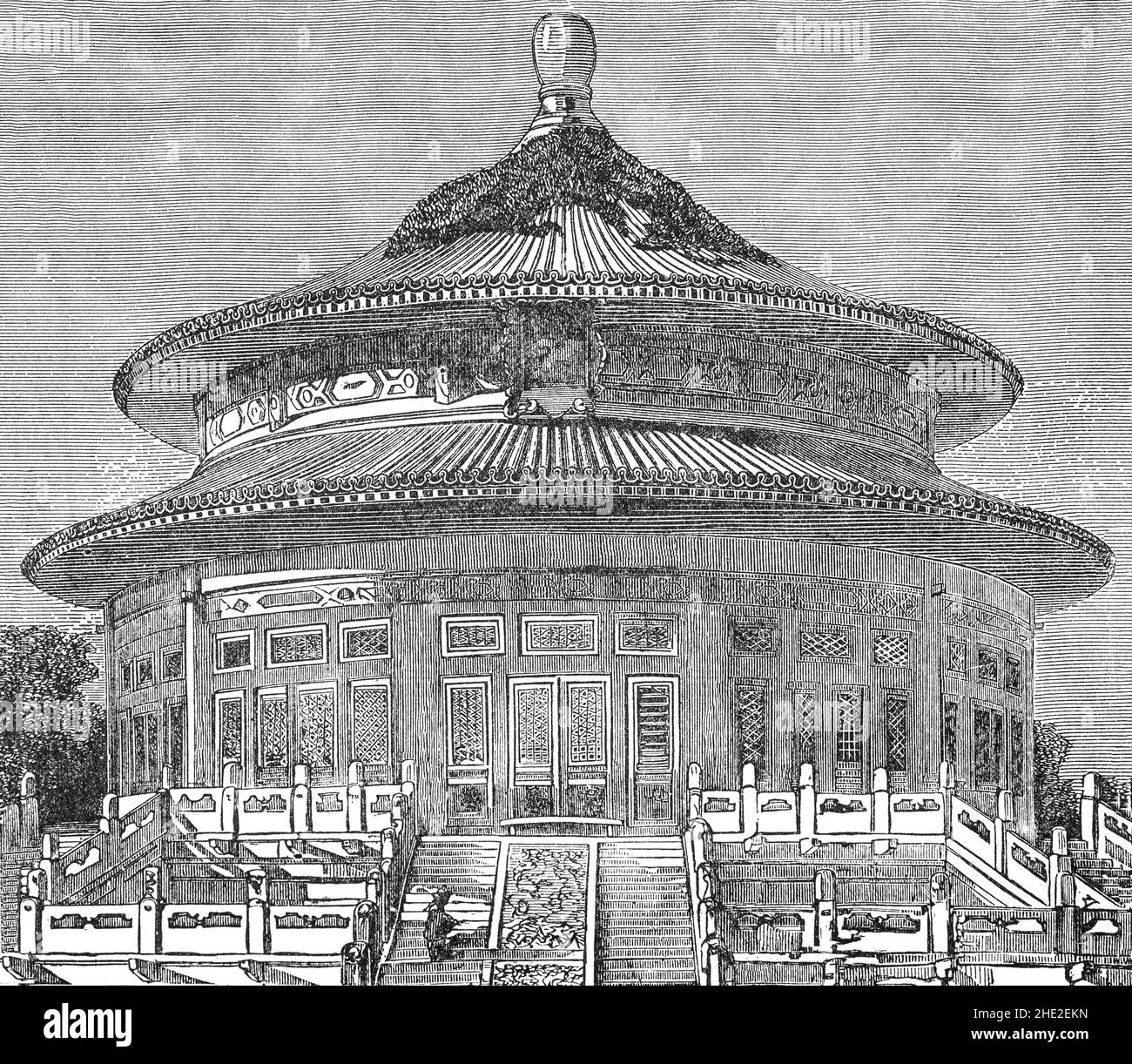 A late 19th Century illustration of The Temple of Heaven, an imperial complex of religious buildings situated in the southeastern part of central Beijing aka Peking. The complex was visited by the Emperors of the Ming and Qing dynasties for annual ceremonies of prayer to Heaven for a good harvest. Chinese temples were used as place of worship where people revere ethnic Chinese gods and ancestors. Stock Photohttps://www.alamy.com/image-license-details/?v=1https://www.alamy.com/a-late-19th-century-illustration-of-the-temple-of-heaven-an-imperial-complex-of-religious-buildings-situated-in-the-southeastern-part-of-central-beijing-aka-peking-the-complex-was-visited-by-the-emperors-of-the-ming-and-qing-dynasties-for-annual-ceremonies-of-prayer-to-heaven-for-a-good-harvest-chinese-temples-were-used-as-place-of-worship-where-people-revere-ethnic-chinese-gods-and-ancestors-image456130185.html
A late 19th Century illustration of The Temple of Heaven, an imperial complex of religious buildings situated in the southeastern part of central Beijing aka Peking. The complex was visited by the Emperors of the Ming and Qing dynasties for annual ceremonies of prayer to Heaven for a good harvest. Chinese temples were used as place of worship where people revere ethnic Chinese gods and ancestors. Stock Photohttps://www.alamy.com/image-license-details/?v=1https://www.alamy.com/a-late-19th-century-illustration-of-the-temple-of-heaven-an-imperial-complex-of-religious-buildings-situated-in-the-southeastern-part-of-central-beijing-aka-peking-the-complex-was-visited-by-the-emperors-of-the-ming-and-qing-dynasties-for-annual-ceremonies-of-prayer-to-heaven-for-a-good-harvest-chinese-temples-were-used-as-place-of-worship-where-people-revere-ethnic-chinese-gods-and-ancestors-image456130185.htmlRM2HE2EKN–A late 19th Century illustration of The Temple of Heaven, an imperial complex of religious buildings situated in the southeastern part of central Beijing aka Peking. The complex was visited by the Emperors of the Ming and Qing dynasties for annual ceremonies of prayer to Heaven for a good harvest. Chinese temples were used as place of worship where people revere ethnic Chinese gods and ancestors.
 Whampoa Pagoda or Chinese Buddhist Temple Hong Kong. Vintage Illustration or Engraving 1860. Stock Photohttps://www.alamy.com/image-license-details/?v=1https://www.alamy.com/whampoa-pagoda-or-chinese-buddhist-temple-hong-kong-vintage-illustration-or-engraving-1860-image464594802.html
Whampoa Pagoda or Chinese Buddhist Temple Hong Kong. Vintage Illustration or Engraving 1860. Stock Photohttps://www.alamy.com/image-license-details/?v=1https://www.alamy.com/whampoa-pagoda-or-chinese-buddhist-temple-hong-kong-vintage-illustration-or-engraving-1860-image464594802.htmlRM2HYT3BE–Whampoa Pagoda or Chinese Buddhist Temple Hong Kong. Vintage Illustration or Engraving 1860.
 Temple of Buddha, Canton, China, 1843. Artist: WH Capone Stock Photohttps://www.alamy.com/image-license-details/?v=1https://www.alamy.com/temple-of-buddha-canton-china-1843-artist-wh-capone-image262765183.html
Temple of Buddha, Canton, China, 1843. Artist: WH Capone Stock Photohttps://www.alamy.com/image-license-details/?v=1https://www.alamy.com/temple-of-buddha-canton-china-1843-artist-wh-capone-image262765183.htmlRMW7DYJR–Temple of Buddha, Canton, China, 1843. Artist: WH Capone
 Chinese Buddhist Temple, between ca. 1910 and ca. 1915, Glass negatives, 1 negative: glass; 5 x 7 in. or smaller. Stock Photohttps://www.alamy.com/image-license-details/?v=1https://www.alamy.com/chinese-buddhist-temple-between-ca-1910-and-ca-1915-glass-negatives-1-negative-glass-5-x-7-in-or-smaller-image623496600.html
Chinese Buddhist Temple, between ca. 1910 and ca. 1915, Glass negatives, 1 negative: glass; 5 x 7 in. or smaller. Stock Photohttps://www.alamy.com/image-license-details/?v=1https://www.alamy.com/chinese-buddhist-temple-between-ca-1910-and-ca-1915-glass-negatives-1-negative-glass-5-x-7-in-or-smaller-image623496600.htmlRM2Y6AM7M–Chinese Buddhist Temple, between ca. 1910 and ca. 1915, Glass negatives, 1 negative: glass; 5 x 7 in. or smaller.
 Candles burning a Chinese Buddhist Temple and Pagoda in Bangkok Thaialnd Stock Photohttps://www.alamy.com/image-license-details/?v=1https://www.alamy.com/stock-photo-candles-burning-a-chinese-buddhist-temple-and-pagoda-in-bangkok-thaialnd-174203064.html
Candles burning a Chinese Buddhist Temple and Pagoda in Bangkok Thaialnd Stock Photohttps://www.alamy.com/image-license-details/?v=1https://www.alamy.com/stock-photo-candles-burning-a-chinese-buddhist-temple-and-pagoda-in-bangkok-thaialnd-174203064.htmlRMM3BHP0–Candles burning a Chinese Buddhist Temple and Pagoda in Bangkok Thaialnd
 CHINA: Superior bonze of a Buddhist temple, antique print 1892 Stock Photohttps://www.alamy.com/image-license-details/?v=1https://www.alamy.com/stock-photo-china-superior-bonze-of-a-buddhist-temple-antique-print-1892-102870290.html
CHINA: Superior bonze of a Buddhist temple, antique print 1892 Stock Photohttps://www.alamy.com/image-license-details/?v=1https://www.alamy.com/stock-photo-china-superior-bonze-of-a-buddhist-temple-antique-print-1892-102870290.htmlRFFYA42X–CHINA: Superior bonze of a Buddhist temple, antique print 1892
 Indonesian Chinese people on the Indonesian Island of Bali using incense to pray at Vihara Dharmayana Buddhist Temple at the Chinese New Year (Xi Gong Stock Photohttps://www.alamy.com/image-license-details/?v=1https://www.alamy.com/indonesian-chinese-people-on-the-indonesian-island-of-bali-using-incense-image151725893.html
Indonesian Chinese people on the Indonesian Island of Bali using incense to pray at Vihara Dharmayana Buddhist Temple at the Chinese New Year (Xi Gong Stock Photohttps://www.alamy.com/image-license-details/?v=1https://www.alamy.com/indonesian-chinese-people-on-the-indonesian-island-of-bali-using-incense-image151725893.htmlRFJPRKWW–Indonesian Chinese people on the Indonesian Island of Bali using incense to pray at Vihara Dharmayana Buddhist Temple at the Chinese New Year (Xi Gong
 Close up of face of a statue of a fierce Chinese Buddhist temple guardian in monochrome with strong shadows Stock Photohttps://www.alamy.com/image-license-details/?v=1https://www.alamy.com/close-up-of-face-of-a-statue-of-a-fierce-chinese-buddhist-temple-guardian-in-monochrome-with-strong-shadows-image182429814.html
Close up of face of a statue of a fierce Chinese Buddhist temple guardian in monochrome with strong shadows Stock Photohttps://www.alamy.com/image-license-details/?v=1https://www.alamy.com/close-up-of-face-of-a-statue-of-a-fierce-chinese-buddhist-temple-guardian-in-monochrome-with-strong-shadows-image182429814.htmlRFMGPB2E–Close up of face of a statue of a fierce Chinese Buddhist temple guardian in monochrome with strong shadows
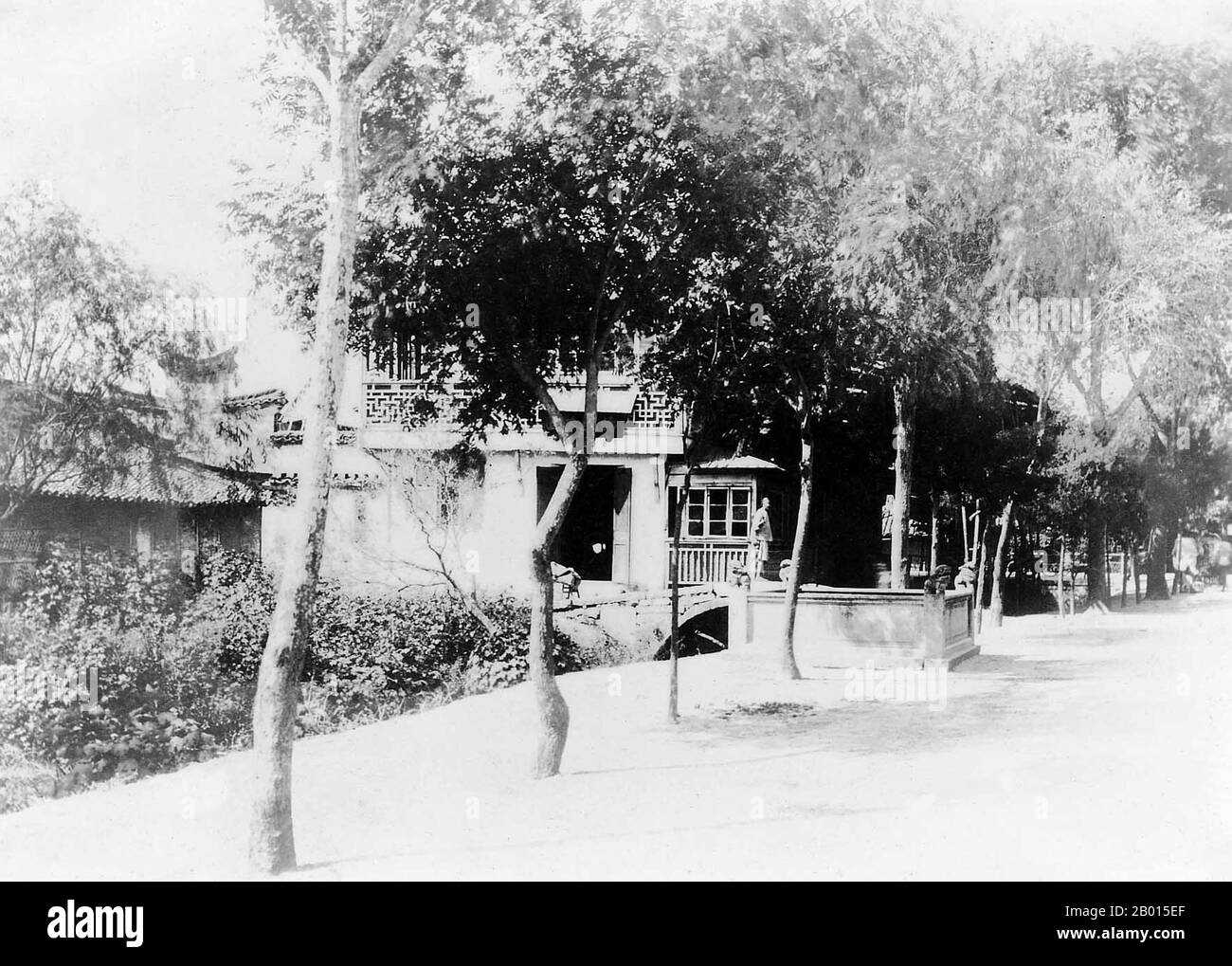 China: Shanghai's Jing'an Temple and the famous 'Bubbling Well', 1890. Jing'an Temple, literally 'Temple of Peace and Tranquility', is a Buddhist temple on West Nanjing Road (formerly 'Bubbling Well Road.), in Jing'an District, Shanghai, China. The first temple was built in 247 CE, at the time of the Kingdom of Wu, during the Three Kingdoms period. Originally located beside Suzhou Creek, it was relocated to its current site in 1216 during the Song Dynasty. The current temple was rebuilt once in the Qing Dynasty. It has recently undergone further renovation. Stock Photohttps://www.alamy.com/image-license-details/?v=1https://www.alamy.com/china-shanghais-jingan-temple-and-the-famous-bubbling-well-1890-jingan-temple-literally-temple-of-peace-and-tranquility-is-a-buddhist-temple-on-west-nanjing-road-formerly-bubbling-well-road-in-jingan-district-shanghai-china-the-first-temple-was-built-in-247-ce-at-the-time-of-the-kingdom-of-wu-during-the-three-kingdoms-period-originally-located-beside-suzhou-creek-it-was-relocated-to-its-current-site-in-1216-during-the-song-dynasty-the-current-temple-was-rebuilt-once-in-the-qing-dynasty-it-has-recently-undergone-further-renovation-image344233639.html
China: Shanghai's Jing'an Temple and the famous 'Bubbling Well', 1890. Jing'an Temple, literally 'Temple of Peace and Tranquility', is a Buddhist temple on West Nanjing Road (formerly 'Bubbling Well Road.), in Jing'an District, Shanghai, China. The first temple was built in 247 CE, at the time of the Kingdom of Wu, during the Three Kingdoms period. Originally located beside Suzhou Creek, it was relocated to its current site in 1216 during the Song Dynasty. The current temple was rebuilt once in the Qing Dynasty. It has recently undergone further renovation. Stock Photohttps://www.alamy.com/image-license-details/?v=1https://www.alamy.com/china-shanghais-jingan-temple-and-the-famous-bubbling-well-1890-jingan-temple-literally-temple-of-peace-and-tranquility-is-a-buddhist-temple-on-west-nanjing-road-formerly-bubbling-well-road-in-jingan-district-shanghai-china-the-first-temple-was-built-in-247-ce-at-the-time-of-the-kingdom-of-wu-during-the-three-kingdoms-period-originally-located-beside-suzhou-creek-it-was-relocated-to-its-current-site-in-1216-during-the-song-dynasty-the-current-temple-was-rebuilt-once-in-the-qing-dynasty-it-has-recently-undergone-further-renovation-image344233639.htmlRM2B015EF–China: Shanghai's Jing'an Temple and the famous 'Bubbling Well', 1890. Jing'an Temple, literally 'Temple of Peace and Tranquility', is a Buddhist temple on West Nanjing Road (formerly 'Bubbling Well Road.), in Jing'an District, Shanghai, China. The first temple was built in 247 CE, at the time of the Kingdom of Wu, during the Three Kingdoms period. Originally located beside Suzhou Creek, it was relocated to its current site in 1216 during the Song Dynasty. The current temple was rebuilt once in the Qing Dynasty. It has recently undergone further renovation.
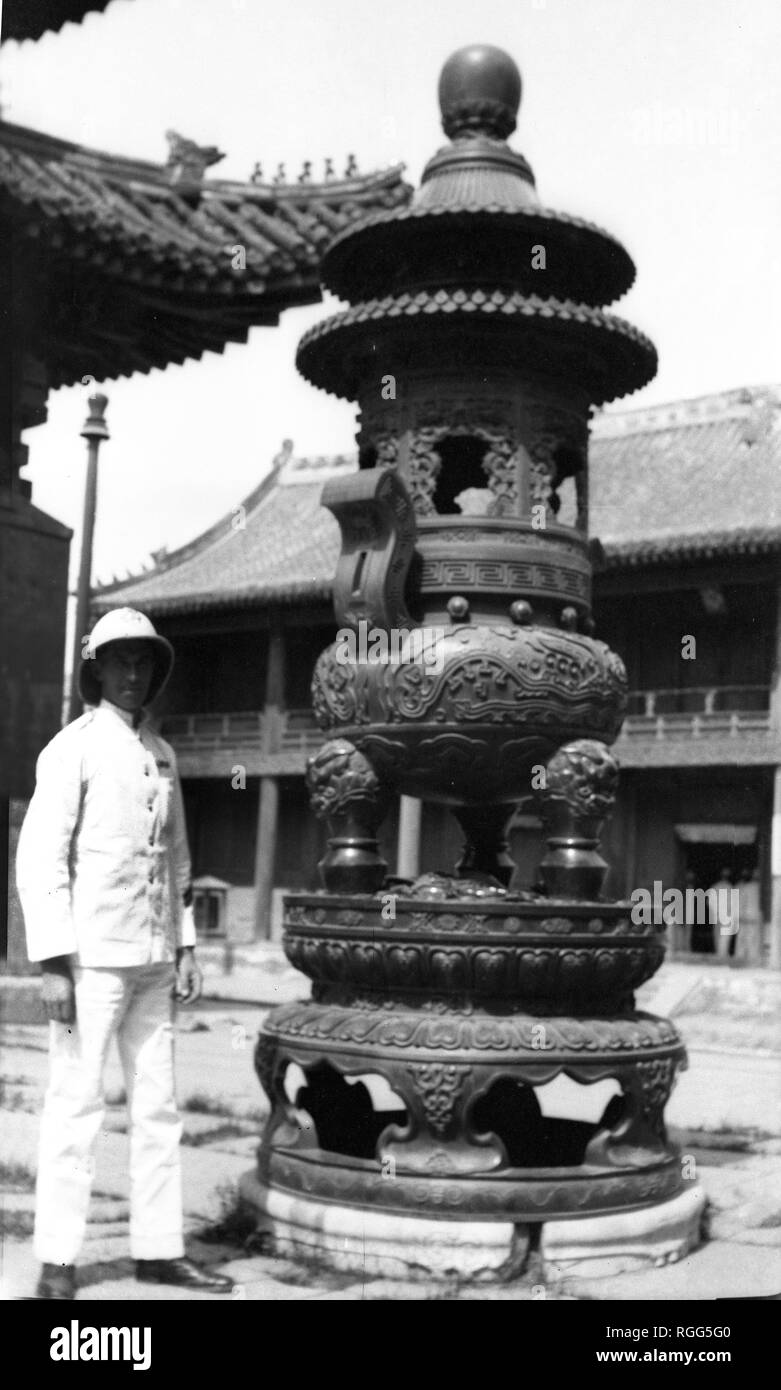 Giant Incense Burner at Buddhist Temple in Peking/Beijing China 1923 Stock Photohttps://www.alamy.com/image-license-details/?v=1https://www.alamy.com/giant-incense-burner-at-buddhist-temple-in-pekingbeijing-china-1923-image233924880.html
Giant Incense Burner at Buddhist Temple in Peking/Beijing China 1923 Stock Photohttps://www.alamy.com/image-license-details/?v=1https://www.alamy.com/giant-incense-burner-at-buddhist-temple-in-pekingbeijing-china-1923-image233924880.htmlRMRGG5G0–Giant Incense Burner at Buddhist Temple in Peking/Beijing China 1923
RM2WKA9BP–The Porcelain Tower of Nanjing, restored around 1640, was an architectural marvel of its time, standing approximately 79 meters tall. It was built with white porcelain bricks that glimmered in the sun, decorated with stone carvings, glazed tiles, and inscriptions. The tower served both as a Buddhist temple and a beacon of light, with lamps that illuminated it at night, creating a magnificent sight. Unfortunately, it was destroyed during the Taiping Rebellion in the 19th century but remains an important symbol of Nanjing's historical and cultural heritage
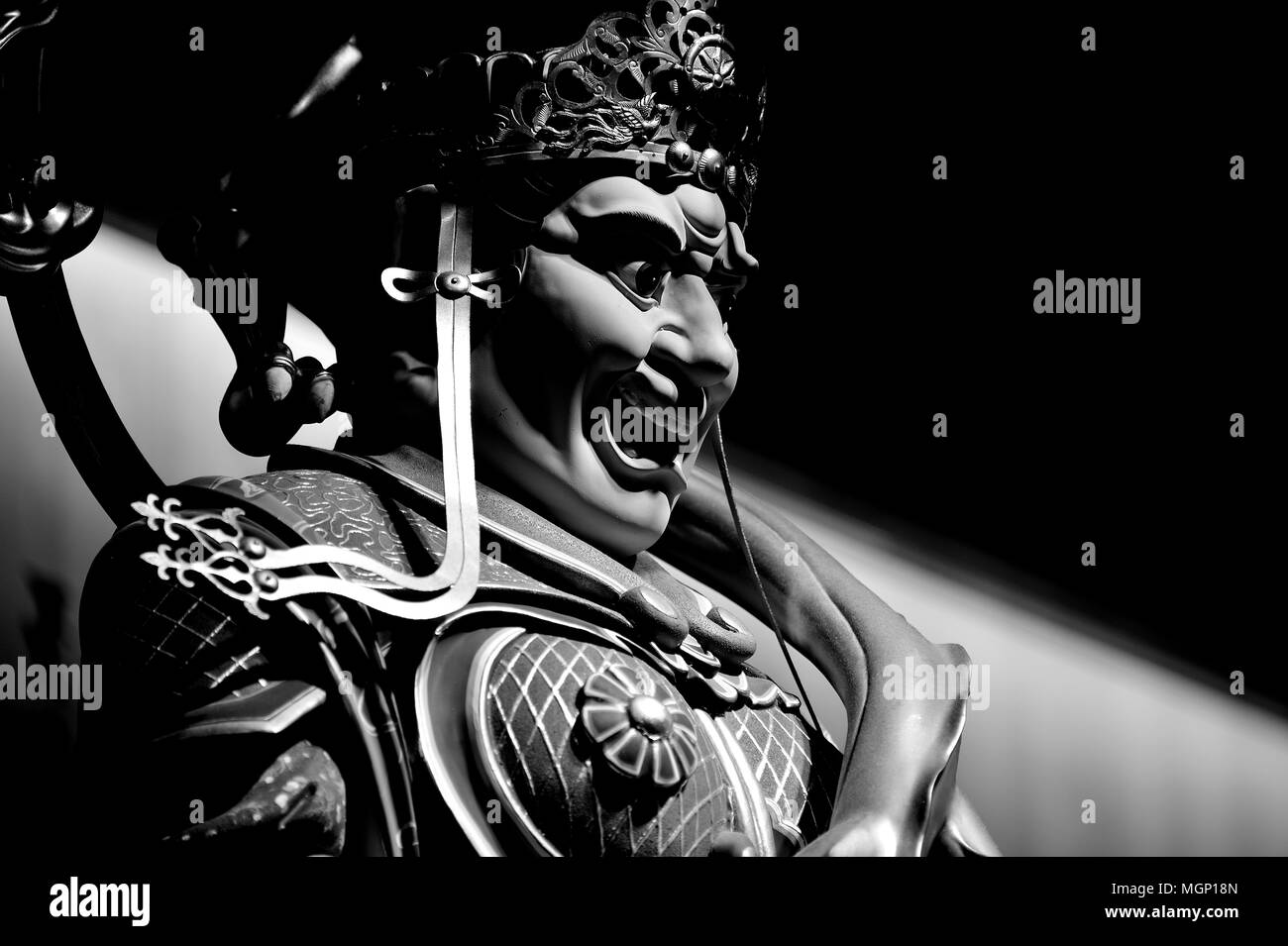 Close up of ancient stone statue of a fierce Chinese Buddhist temple guardian in monochrome with strong shadows as Asian art with space for copy Stock Photohttps://www.alamy.com/image-license-details/?v=1https://www.alamy.com/close-up-of-ancient-stone-statue-of-a-fierce-chinese-buddhist-temple-guardian-in-monochrome-with-strong-shadows-as-asian-art-with-space-for-copy-image182422149.html
Close up of ancient stone statue of a fierce Chinese Buddhist temple guardian in monochrome with strong shadows as Asian art with space for copy Stock Photohttps://www.alamy.com/image-license-details/?v=1https://www.alamy.com/close-up-of-ancient-stone-statue-of-a-fierce-chinese-buddhist-temple-guardian-in-monochrome-with-strong-shadows-as-asian-art-with-space-for-copy-image182422149.htmlRFMGP18N–Close up of ancient stone statue of a fierce Chinese Buddhist temple guardian in monochrome with strong shadows as Asian art with space for copy
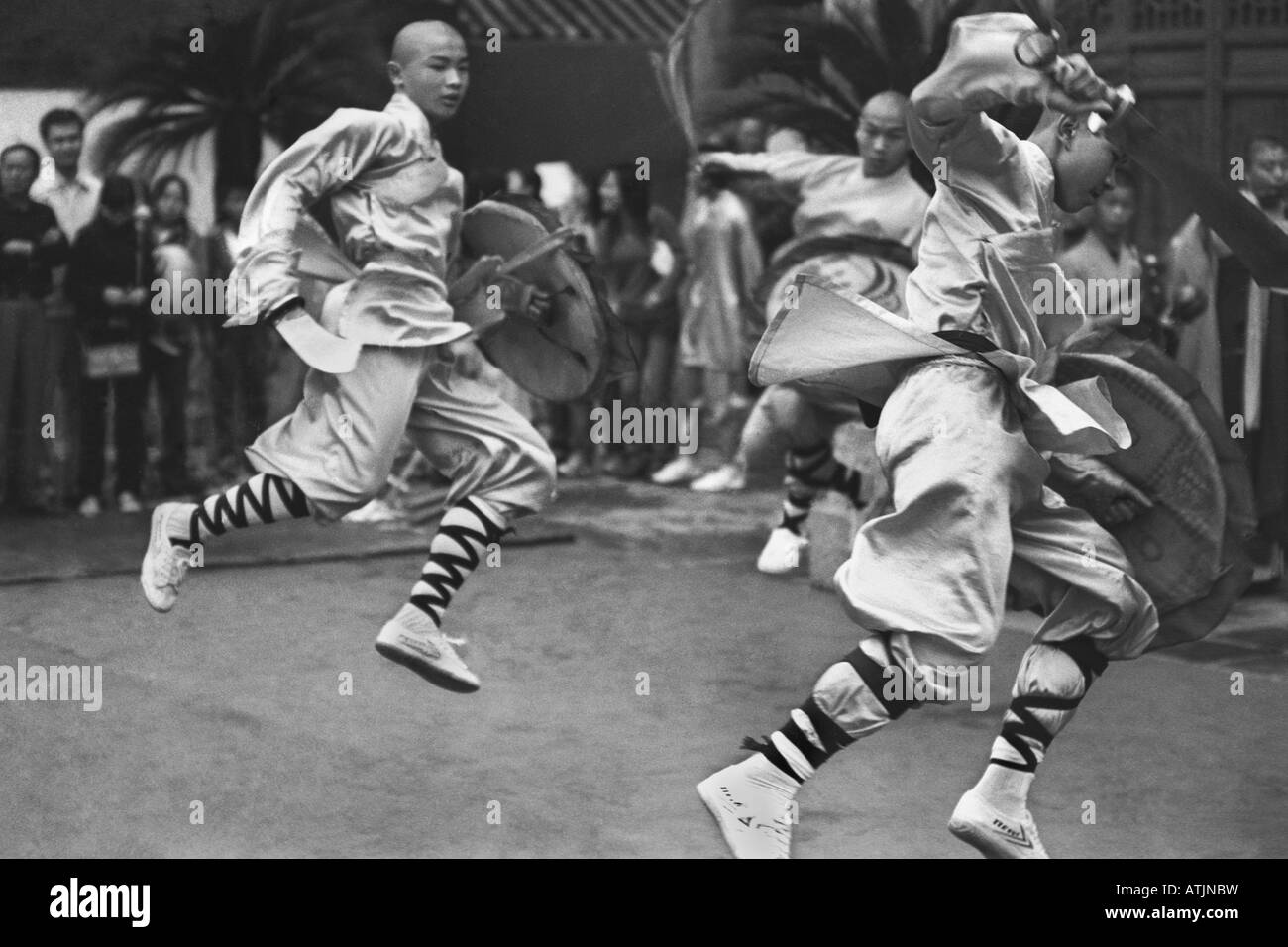 The Shaolin temple monks are high in the air Stock Photohttps://www.alamy.com/image-license-details/?v=1https://www.alamy.com/stock-photo-the-shaolin-temple-monks-are-high-in-the-air-16333212.html
The Shaolin temple monks are high in the air Stock Photohttps://www.alamy.com/image-license-details/?v=1https://www.alamy.com/stock-photo-the-shaolin-temple-monks-are-high-in-the-air-16333212.htmlRMATJNBW–The Shaolin temple monks are high in the air
RF2Y7YXE7–China temple old ancient historical Buddhist religion worship place Chinese architecture oriental building design icon set
 Chinese Torture by Crushing inside Pagoda or Buddhist Temple in Tianjin China. Vintage of Historic Engraving or Illustration 1864 Stock Photohttps://www.alamy.com/image-license-details/?v=1https://www.alamy.com/chinese-torture-by-crushing-inside-pagoda-or-buddhist-temple-in-tianjin-china-vintage-of-historic-engraving-or-illustration-1864-image635794068.html
Chinese Torture by Crushing inside Pagoda or Buddhist Temple in Tianjin China. Vintage of Historic Engraving or Illustration 1864 Stock Photohttps://www.alamy.com/image-license-details/?v=1https://www.alamy.com/chinese-torture-by-crushing-inside-pagoda-or-buddhist-temple-in-tianjin-china-vintage-of-historic-engraving-or-illustration-1864-image635794068.htmlRM2YXAWR0–Chinese Torture by Crushing inside Pagoda or Buddhist Temple in Tianjin China. Vintage of Historic Engraving or Illustration 1864
 Small Buddhist temple in Hutong of Beijing Stock Photohttps://www.alamy.com/image-license-details/?v=1https://www.alamy.com/small-buddhist-temple-in-hutong-of-beijing-image7922951.html
Small Buddhist temple in Hutong of Beijing Stock Photohttps://www.alamy.com/image-license-details/?v=1https://www.alamy.com/small-buddhist-temple-in-hutong-of-beijing-image7922951.htmlRFAF8CG8–Small Buddhist temple in Hutong of Beijing
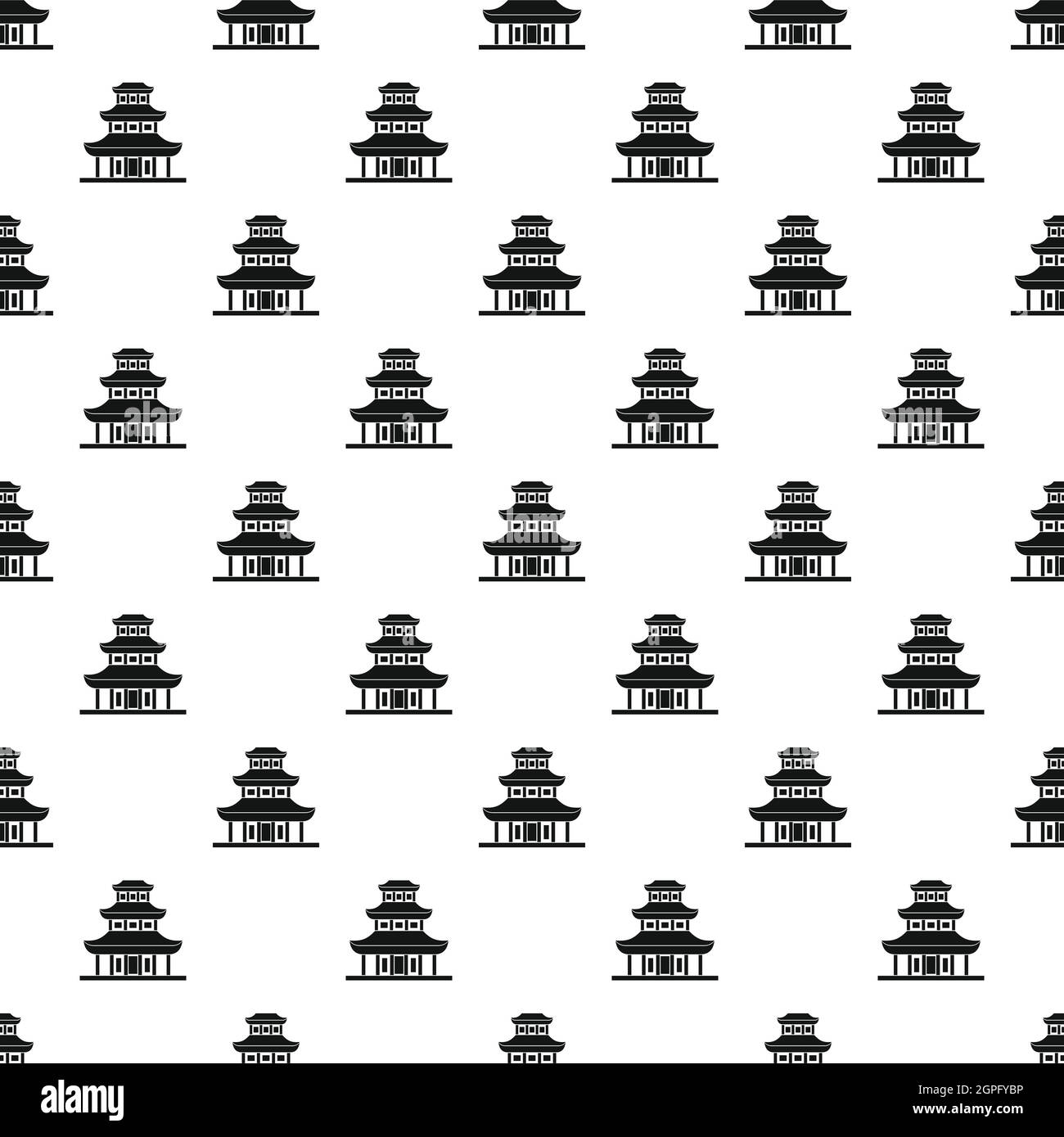 Buddhist temple pattern, simple style Stock Vectorhttps://www.alamy.com/image-license-details/?v=1https://www.alamy.com/buddhist-temple-pattern-simple-style-image444132410.html
Buddhist temple pattern, simple style Stock Vectorhttps://www.alamy.com/image-license-details/?v=1https://www.alamy.com/buddhist-temple-pattern-simple-style-image444132410.htmlRF2GPFYBP–Buddhist temple pattern, simple style
![Chinese Buddhist Temple [between ca. 1910 and ca. 1915] Stock Photo Chinese Buddhist Temple [between ca. 1910 and ca. 1915] Stock Photo](https://c8.alamy.com/comp/2AW00F0/chinese-buddhist-temple-between-ca-1910-and-ca-1915-2AW00F0.jpg) Chinese Buddhist Temple [between ca. 1910 and ca. 1915] Stock Photohttps://www.alamy.com/image-license-details/?v=1https://www.alamy.com/chinese-buddhist-temple-between-ca-1910-and-ca-1915-image342363812.html
Chinese Buddhist Temple [between ca. 1910 and ca. 1915] Stock Photohttps://www.alamy.com/image-license-details/?v=1https://www.alamy.com/chinese-buddhist-temple-between-ca-1910-and-ca-1915-image342363812.htmlRM2AW00F0–Chinese Buddhist Temple [between ca. 1910 and ca. 1915]
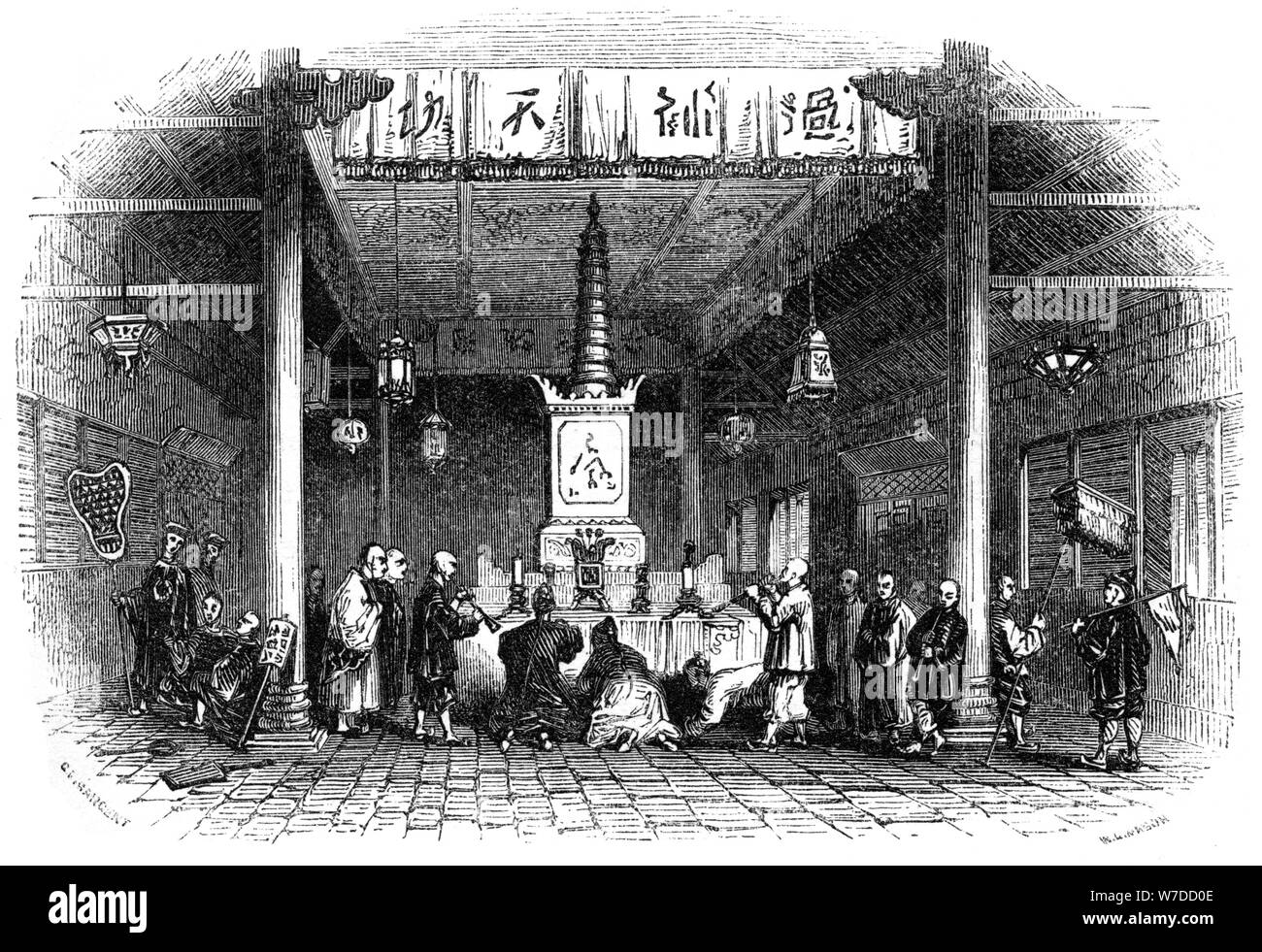 Buddhist temple, China, 1847. Artist: Mason Stock Photohttps://www.alamy.com/image-license-details/?v=1https://www.alamy.com/buddhist-temple-china-1847-artist-mason-image262753694.html
Buddhist temple, China, 1847. Artist: Mason Stock Photohttps://www.alamy.com/image-license-details/?v=1https://www.alamy.com/buddhist-temple-china-1847-artist-mason-image262753694.htmlRMW7DD0E–Buddhist temple, China, 1847. Artist: Mason
 A late 19th Century illustration of the interior of a priest in a Chinese temple, used as place of worship of Chinese Buddhism, Taoism or Chinese folk religion, where people revere ethnic Chinese gods and ancestors. Stock Photohttps://www.alamy.com/image-license-details/?v=1https://www.alamy.com/a-late-19th-century-illustration-of-the-interior-of-a-priest-in-a-chinese-temple-used-as-place-of-worship-of-chinese-buddhism-taoism-or-chinese-folk-religion-where-people-revere-ethnic-chinese-gods-and-ancestors-image456130291.html
A late 19th Century illustration of the interior of a priest in a Chinese temple, used as place of worship of Chinese Buddhism, Taoism or Chinese folk religion, where people revere ethnic Chinese gods and ancestors. Stock Photohttps://www.alamy.com/image-license-details/?v=1https://www.alamy.com/a-late-19th-century-illustration-of-the-interior-of-a-priest-in-a-chinese-temple-used-as-place-of-worship-of-chinese-buddhism-taoism-or-chinese-folk-religion-where-people-revere-ethnic-chinese-gods-and-ancestors-image456130291.htmlRM2HE2ERF–A late 19th Century illustration of the interior of a priest in a Chinese temple, used as place of worship of Chinese Buddhism, Taoism or Chinese folk religion, where people revere ethnic Chinese gods and ancestors.
 Lijiang, China - September 22, 2017: Prayers and wishes on wooden plates hanged in a temple by the White Water River in Blue Moon Valley. Stock Photohttps://www.alamy.com/image-license-details/?v=1https://www.alamy.com/stock-photo-lijiang-china-september-22-2017-prayers-and-wishes-on-wooden-plates-173704430.html
Lijiang, China - September 22, 2017: Prayers and wishes on wooden plates hanged in a temple by the White Water River in Blue Moon Valley. Stock Photohttps://www.alamy.com/image-license-details/?v=1https://www.alamy.com/stock-photo-lijiang-china-september-22-2017-prayers-and-wishes-on-wooden-plates-173704430.htmlRFM2GWNJ–Lijiang, China - September 22, 2017: Prayers and wishes on wooden plates hanged in a temple by the White Water River in Blue Moon Valley.
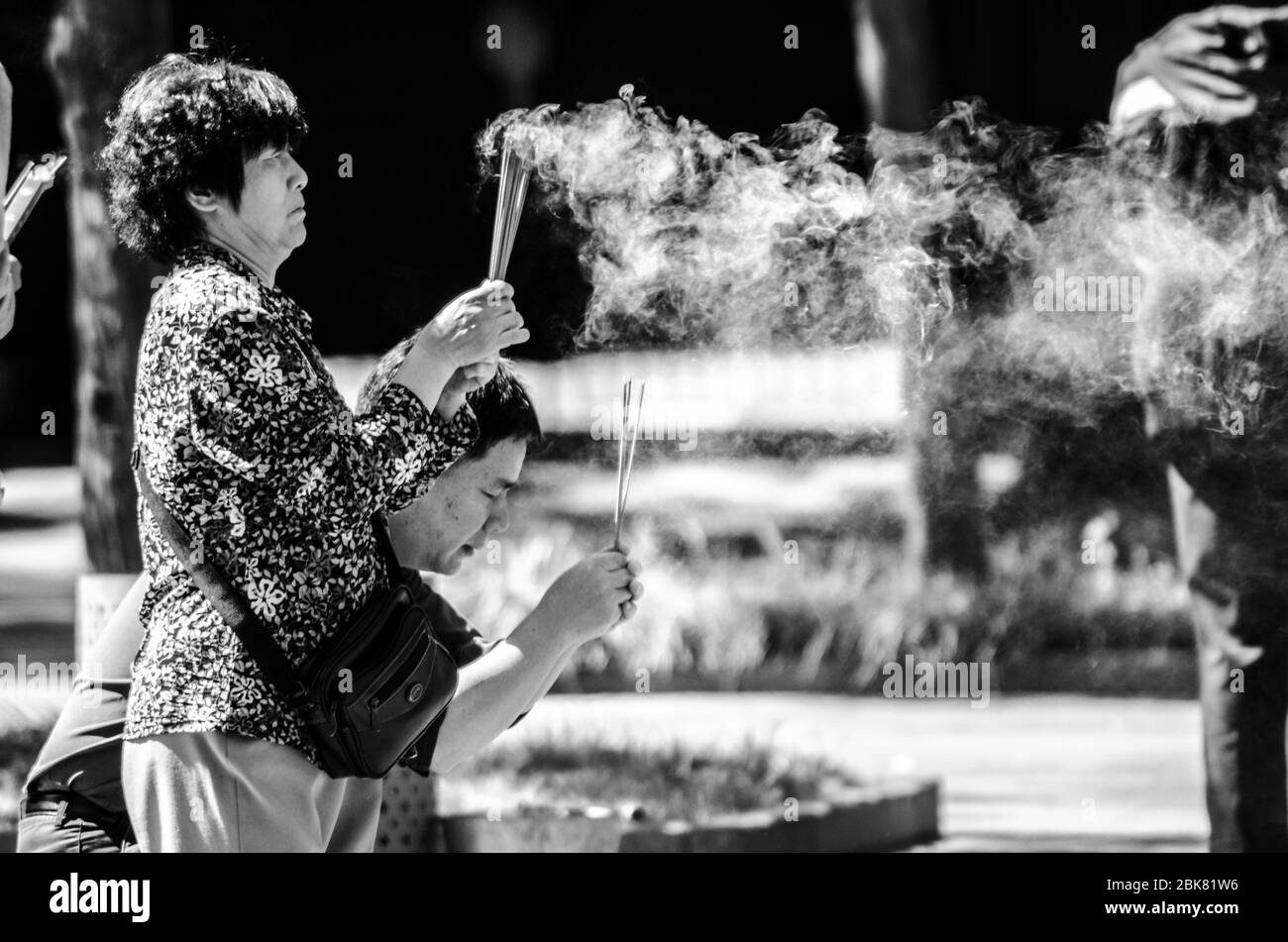 temple prayers Stock Photohttps://www.alamy.com/image-license-details/?v=1https://www.alamy.com/temple-prayers-image356062930.html
temple prayers Stock Photohttps://www.alamy.com/image-license-details/?v=1https://www.alamy.com/temple-prayers-image356062930.htmlRM2BK81W6–temple prayers
 Chinese Asian China Religion Culture Tradition Stick Figure Pictogram Icon Stock Vectorhttps://www.alamy.com/image-license-details/?v=1https://www.alamy.com/stock-photo-chinese-asian-china-religion-culture-tradition-stick-figure-pictogram-89509287.html
Chinese Asian China Religion Culture Tradition Stick Figure Pictogram Icon Stock Vectorhttps://www.alamy.com/image-license-details/?v=1https://www.alamy.com/stock-photo-chinese-asian-china-religion-culture-tradition-stick-figure-pictogram-89509287.htmlRFF5HE07–Chinese Asian China Religion Culture Tradition Stick Figure Pictogram Icon
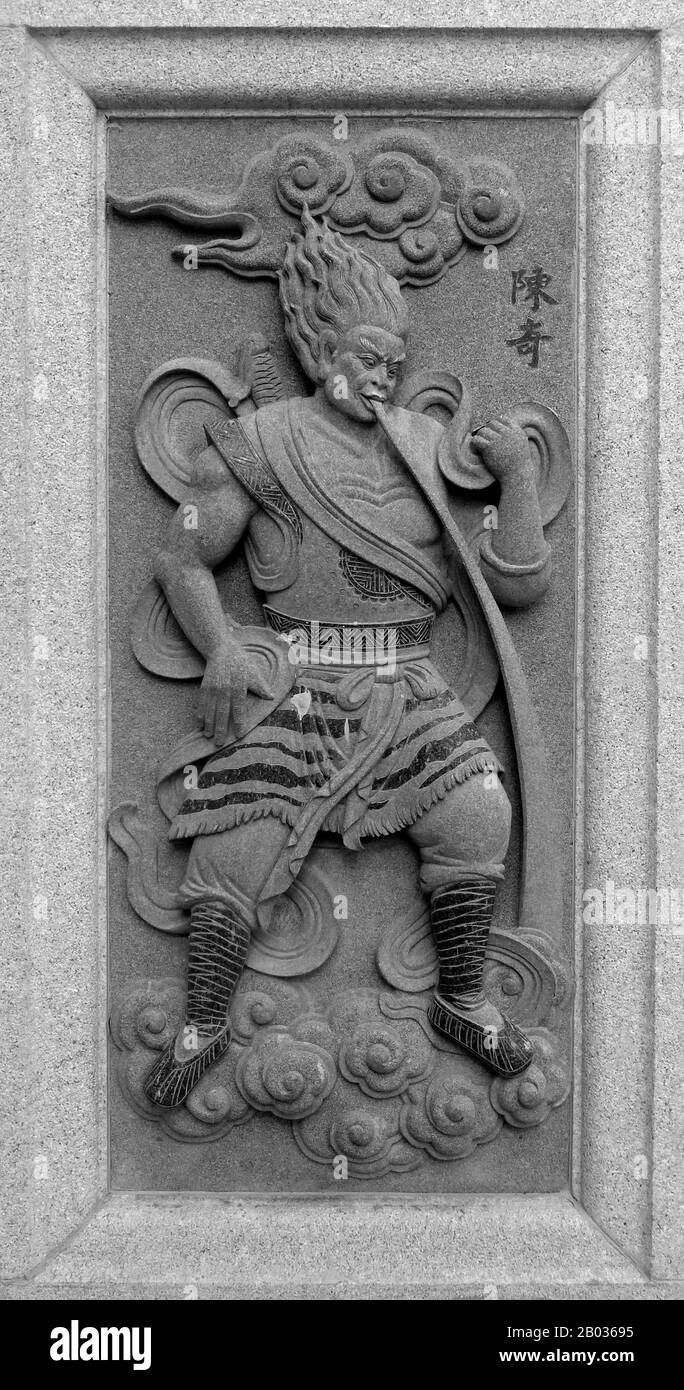 Malaysia / China: Carving of Chen Qi, depicting his role in the 16th Century Ming Dynasty novel Fengshen Yanyi ('Investiture of the Gods'). From Ping Sien Si Temple, Pasir Panjang Laut. Photo by Anandajoti (CC BY 2.0). At the end of 'Fengshen Yanyi', Zheng Lu and fellow student of Due Zhenren, Chen Qi, were raised up to become the deities of Heng Ha Erjiang, celestial officers and door guardians to sacred temples of the Buddha. Stock Photohttps://www.alamy.com/image-license-details/?v=1https://www.alamy.com/malaysia-china-carving-of-chen-qi-depicting-his-role-in-the-16th-century-ming-dynasty-novel-fengshen-yanyi-investiture-of-the-gods-from-ping-sien-si-temple-pasir-panjang-laut-photo-by-anandajoti-cc-by-20-at-the-end-of-fengshen-yanyi-zheng-lu-and-fellow-student-of-due-zhenren-chen-qi-were-raised-up-to-become-the-deities-of-heng-ha-erjiang-celestial-officers-and-door-guardians-to-sacred-temples-of-the-buddha-image344278177.html
Malaysia / China: Carving of Chen Qi, depicting his role in the 16th Century Ming Dynasty novel Fengshen Yanyi ('Investiture of the Gods'). From Ping Sien Si Temple, Pasir Panjang Laut. Photo by Anandajoti (CC BY 2.0). At the end of 'Fengshen Yanyi', Zheng Lu and fellow student of Due Zhenren, Chen Qi, were raised up to become the deities of Heng Ha Erjiang, celestial officers and door guardians to sacred temples of the Buddha. Stock Photohttps://www.alamy.com/image-license-details/?v=1https://www.alamy.com/malaysia-china-carving-of-chen-qi-depicting-his-role-in-the-16th-century-ming-dynasty-novel-fengshen-yanyi-investiture-of-the-gods-from-ping-sien-si-temple-pasir-panjang-laut-photo-by-anandajoti-cc-by-20-at-the-end-of-fengshen-yanyi-zheng-lu-and-fellow-student-of-due-zhenren-chen-qi-were-raised-up-to-become-the-deities-of-heng-ha-erjiang-celestial-officers-and-door-guardians-to-sacred-temples-of-the-buddha-image344278177.htmlRM2B03695–Malaysia / China: Carving of Chen Qi, depicting his role in the 16th Century Ming Dynasty novel Fengshen Yanyi ('Investiture of the Gods'). From Ping Sien Si Temple, Pasir Panjang Laut. Photo by Anandajoti (CC BY 2.0). At the end of 'Fengshen Yanyi', Zheng Lu and fellow student of Due Zhenren, Chen Qi, were raised up to become the deities of Heng Ha Erjiang, celestial officers and door guardians to sacred temples of the Buddha.
 CHINA: Religious Ceremony in a Chinese Lamasery (Buddhist Temple) , print 1892 Stock Photohttps://www.alamy.com/image-license-details/?v=1https://www.alamy.com/stock-photo-china-religious-ceremony-in-a-chinese-lamasery-buddhist-temple-print-102870274.html
CHINA: Religious Ceremony in a Chinese Lamasery (Buddhist Temple) , print 1892 Stock Photohttps://www.alamy.com/image-license-details/?v=1https://www.alamy.com/stock-photo-china-religious-ceremony-in-a-chinese-lamasery-buddhist-temple-print-102870274.htmlRFFYA42A–CHINA: Religious Ceremony in a Chinese Lamasery (Buddhist Temple) , print 1892
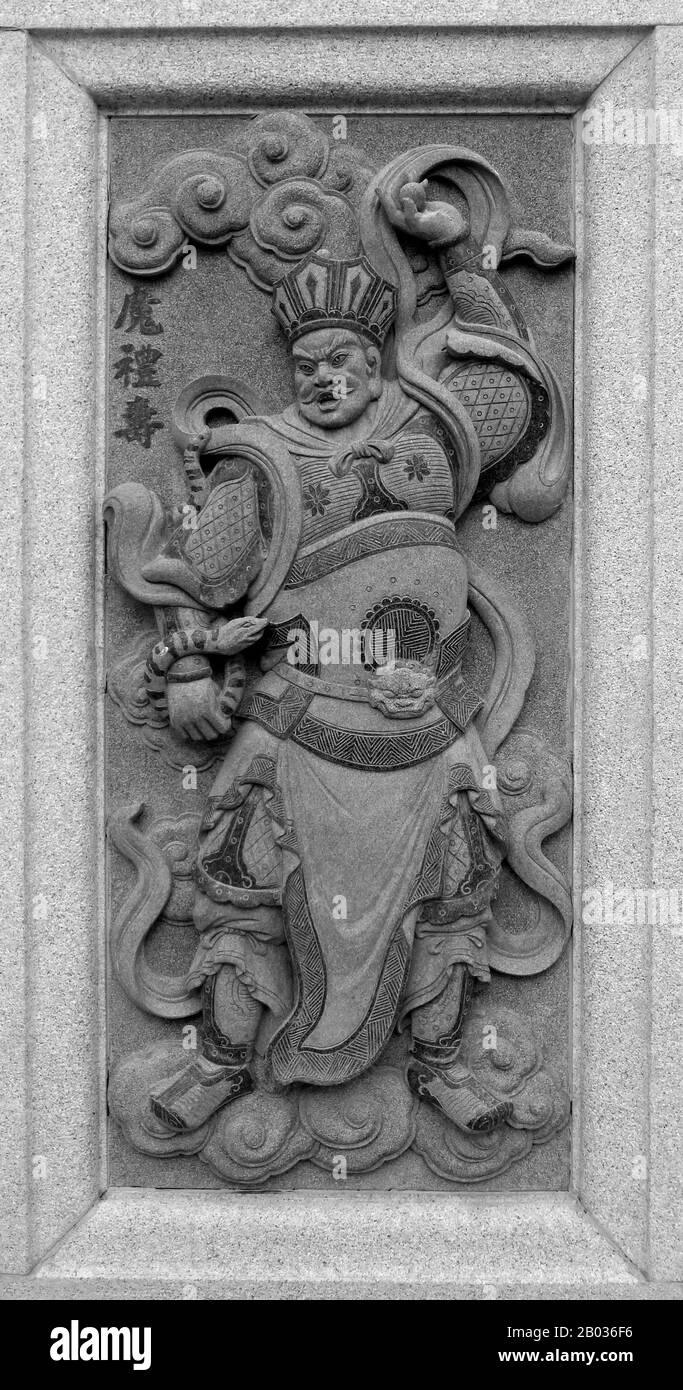 Malaysia / China: Carving of the Diamond King Mo-Li Hai, Guardian of the North, depicting his role in the 16th Century Ming Dynasty novel Fengshen Yanyi ('Investiture of the Gods'). From Ping Sien Si Temple, Pasir Panjang Laut. Photo by Anandajoti (CC BY 2.0). A Taoist deity, Mo-Li Shou was one of the Four Diamond Kings, and Guardian of the North. He is often depicted with a black face and holding two whips, as well as a pearl and a bag made of panther skin containing the rat Hua-Hu Tiao. He also plays a small role in the classic Ming Dynasty novel 'Fengshen Yanyi'. Stock Photohttps://www.alamy.com/image-license-details/?v=1https://www.alamy.com/malaysia-china-carving-of-the-diamond-king-mo-li-hai-guardian-of-the-north-depicting-his-role-in-the-16th-century-ming-dynasty-novel-fengshen-yanyi-investiture-of-the-gods-from-ping-sien-si-temple-pasir-panjang-laut-photo-by-anandajoti-cc-by-20-a-taoist-deity-mo-li-shou-was-one-of-the-four-diamond-kings-and-guardian-of-the-north-he-is-often-depicted-with-a-black-face-and-holding-two-whips-as-well-as-a-pearl-and-a-bag-made-of-panther-skin-containing-the-rat-hua-hu-tiao-he-also-plays-a-small-role-in-the-classic-ming-dynasty-novel-fengshen-yanyi-image344278346.html
Malaysia / China: Carving of the Diamond King Mo-Li Hai, Guardian of the North, depicting his role in the 16th Century Ming Dynasty novel Fengshen Yanyi ('Investiture of the Gods'). From Ping Sien Si Temple, Pasir Panjang Laut. Photo by Anandajoti (CC BY 2.0). A Taoist deity, Mo-Li Shou was one of the Four Diamond Kings, and Guardian of the North. He is often depicted with a black face and holding two whips, as well as a pearl and a bag made of panther skin containing the rat Hua-Hu Tiao. He also plays a small role in the classic Ming Dynasty novel 'Fengshen Yanyi'. Stock Photohttps://www.alamy.com/image-license-details/?v=1https://www.alamy.com/malaysia-china-carving-of-the-diamond-king-mo-li-hai-guardian-of-the-north-depicting-his-role-in-the-16th-century-ming-dynasty-novel-fengshen-yanyi-investiture-of-the-gods-from-ping-sien-si-temple-pasir-panjang-laut-photo-by-anandajoti-cc-by-20-a-taoist-deity-mo-li-shou-was-one-of-the-four-diamond-kings-and-guardian-of-the-north-he-is-often-depicted-with-a-black-face-and-holding-two-whips-as-well-as-a-pearl-and-a-bag-made-of-panther-skin-containing-the-rat-hua-hu-tiao-he-also-plays-a-small-role-in-the-classic-ming-dynasty-novel-fengshen-yanyi-image344278346.htmlRM2B036F6–Malaysia / China: Carving of the Diamond King Mo-Li Hai, Guardian of the North, depicting his role in the 16th Century Ming Dynasty novel Fengshen Yanyi ('Investiture of the Gods'). From Ping Sien Si Temple, Pasir Panjang Laut. Photo by Anandajoti (CC BY 2.0). A Taoist deity, Mo-Li Shou was one of the Four Diamond Kings, and Guardian of the North. He is often depicted with a black face and holding two whips, as well as a pearl and a bag made of panther skin containing the rat Hua-Hu Tiao. He also plays a small role in the classic Ming Dynasty novel 'Fengshen Yanyi'.
 1920s CARVED WOOD EFFIGY STATUE OF THE BUDDHA IN A CHINESE TEMPLE BUDDHIST RELIGION Stock Photohttps://www.alamy.com/image-license-details/?v=1https://www.alamy.com/stock-photo-1920s-carved-wood-effigy-statue-of-the-buddha-in-a-chinese-temple-12665972.html
1920s CARVED WOOD EFFIGY STATUE OF THE BUDDHA IN A CHINESE TEMPLE BUDDHIST RELIGION Stock Photohttps://www.alamy.com/image-license-details/?v=1https://www.alamy.com/stock-photo-1920s-carved-wood-effigy-statue-of-the-buddha-in-a-chinese-temple-12665972.htmlRMAAMY0N–1920s CARVED WOOD EFFIGY STATUE OF THE BUDDHA IN A CHINESE TEMPLE BUDDHIST RELIGION
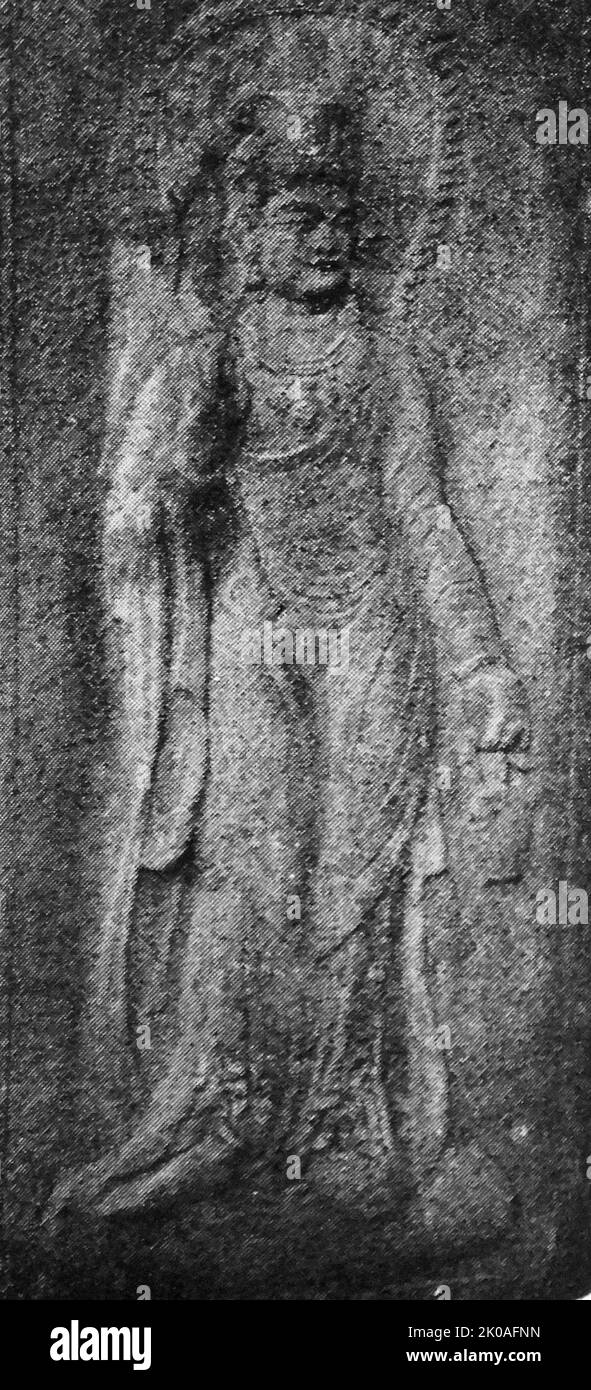 Granite: relief on the right wall of the Seokguram Grotto (Cave Temple) in Kyeongju, South Korea. The Seokguram grotto is registered as a UNESCO World Heritage and as the Korean National Treasure number 24. The Seokguram Grotto was initiated in 751 by King Kyeongdeok of Silla and completed by his son in 774 by King Hyegong of Silla. The Grotto was built to illustrate the moment when Sakyamuni achieved the Enlightenment. Sculpture from the time of Unified Silla (668 - 935) Stock Photohttps://www.alamy.com/image-license-details/?v=1https://www.alamy.com/granite-relief-on-the-right-wall-of-the-seokguram-grotto-cave-temple-in-kyeongju-south-korea-the-seokguram-grotto-is-registered-as-a-unesco-world-heritage-and-as-the-korean-national-treasure-number-24-the-seokguram-grotto-was-initiated-in-751-by-king-kyeongdeok-of-silla-and-completed-by-his-son-in-774-by-king-hyegong-of-silla-the-grotto-was-built-to-illustrate-the-moment-when-sakyamuni-achieved-the-enlightenment-sculpture-from-the-time-of-unified-silla-668-935-image482122193.html
Granite: relief on the right wall of the Seokguram Grotto (Cave Temple) in Kyeongju, South Korea. The Seokguram grotto is registered as a UNESCO World Heritage and as the Korean National Treasure number 24. The Seokguram Grotto was initiated in 751 by King Kyeongdeok of Silla and completed by his son in 774 by King Hyegong of Silla. The Grotto was built to illustrate the moment when Sakyamuni achieved the Enlightenment. Sculpture from the time of Unified Silla (668 - 935) Stock Photohttps://www.alamy.com/image-license-details/?v=1https://www.alamy.com/granite-relief-on-the-right-wall-of-the-seokguram-grotto-cave-temple-in-kyeongju-south-korea-the-seokguram-grotto-is-registered-as-a-unesco-world-heritage-and-as-the-korean-national-treasure-number-24-the-seokguram-grotto-was-initiated-in-751-by-king-kyeongdeok-of-silla-and-completed-by-his-son-in-774-by-king-hyegong-of-silla-the-grotto-was-built-to-illustrate-the-moment-when-sakyamuni-achieved-the-enlightenment-sculpture-from-the-time-of-unified-silla-668-935-image482122193.htmlRM2K0AFNN–Granite: relief on the right wall of the Seokguram Grotto (Cave Temple) in Kyeongju, South Korea. The Seokguram grotto is registered as a UNESCO World Heritage and as the Korean National Treasure number 24. The Seokguram Grotto was initiated in 751 by King Kyeongdeok of Silla and completed by his son in 774 by King Hyegong of Silla. The Grotto was built to illustrate the moment when Sakyamuni achieved the Enlightenment. Sculpture from the time of Unified Silla (668 - 935)
 Chinese tale carving at temple Stock Photohttps://www.alamy.com/image-license-details/?v=1https://www.alamy.com/chinese-tale-carving-at-temple-image388517265.html
Chinese tale carving at temple Stock Photohttps://www.alamy.com/image-license-details/?v=1https://www.alamy.com/chinese-tale-carving-at-temple-image388517265.htmlRF2DG2DMH–Chinese tale carving at temple
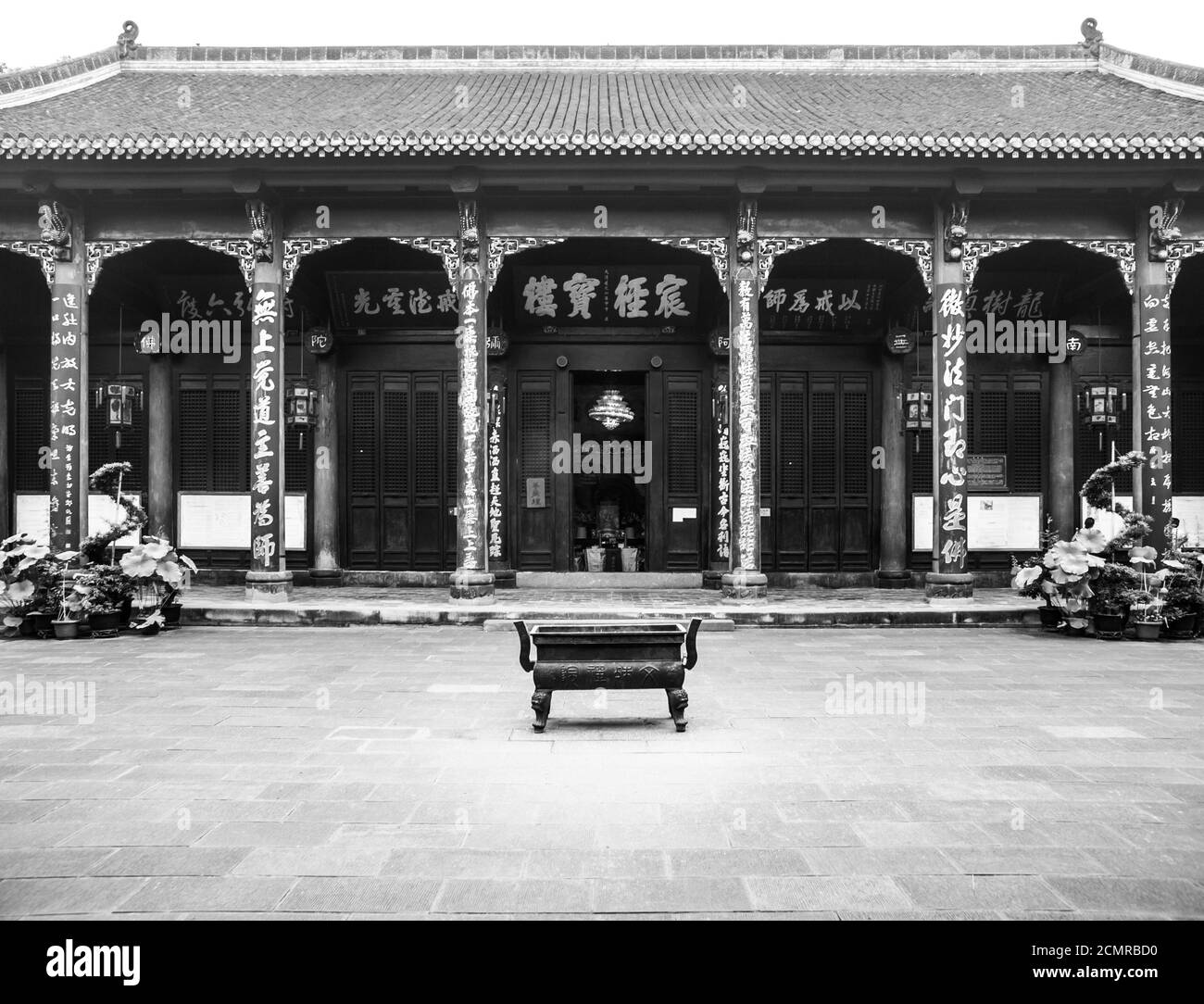 Courtyard in Wenshu Buddhist Monastery, Manjushri, Chengdu in Sichuan Province, China, black and white image Stock Photohttps://www.alamy.com/image-license-details/?v=1https://www.alamy.com/courtyard-in-wenshu-buddhist-monastery-manjushri-chengdu-in-sichuan-province-china-black-and-white-image-image374224732.html
Courtyard in Wenshu Buddhist Monastery, Manjushri, Chengdu in Sichuan Province, China, black and white image Stock Photohttps://www.alamy.com/image-license-details/?v=1https://www.alamy.com/courtyard-in-wenshu-buddhist-monastery-manjushri-chengdu-in-sichuan-province-china-black-and-white-image-image374224732.htmlRF2CMRBD0–Courtyard in Wenshu Buddhist Monastery, Manjushri, Chengdu in Sichuan Province, China, black and white image
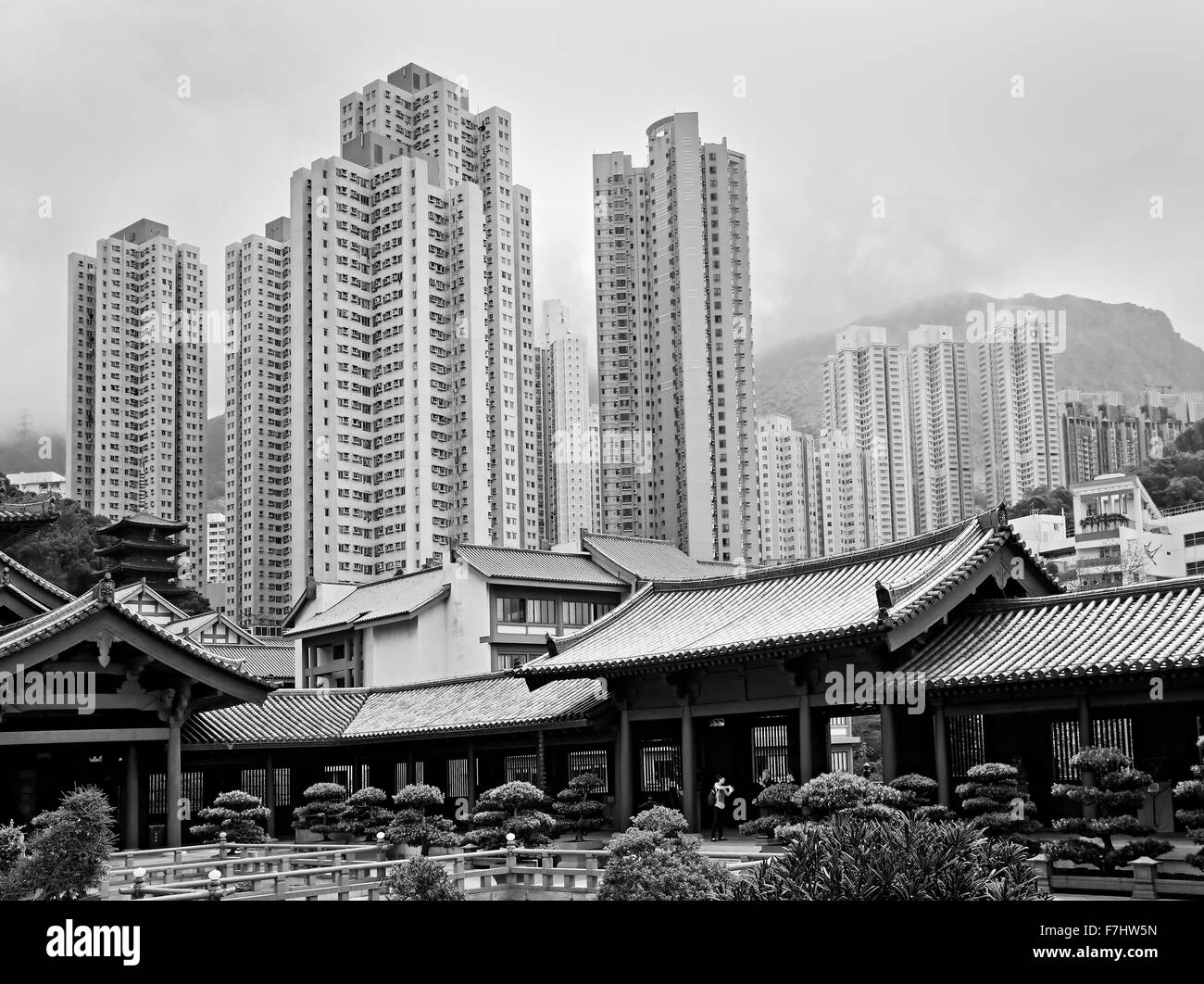 Chi Lin Nunnery with Hong Kong Skyline in the background. It was founded in 1934 as a retreat for Buddhist nuns and was rebuilt in the 1990s Stock Photohttps://www.alamy.com/image-license-details/?v=1https://www.alamy.com/stock-photo-chi-lin-nunnery-with-hong-kong-skyline-in-the-background-it-was-founded-90747377.html
Chi Lin Nunnery with Hong Kong Skyline in the background. It was founded in 1934 as a retreat for Buddhist nuns and was rebuilt in the 1990s Stock Photohttps://www.alamy.com/image-license-details/?v=1https://www.alamy.com/stock-photo-chi-lin-nunnery-with-hong-kong-skyline-in-the-background-it-was-founded-90747377.htmlRMF7HW5N–Chi Lin Nunnery with Hong Kong Skyline in the background. It was founded in 1934 as a retreat for Buddhist nuns and was rebuilt in the 1990s
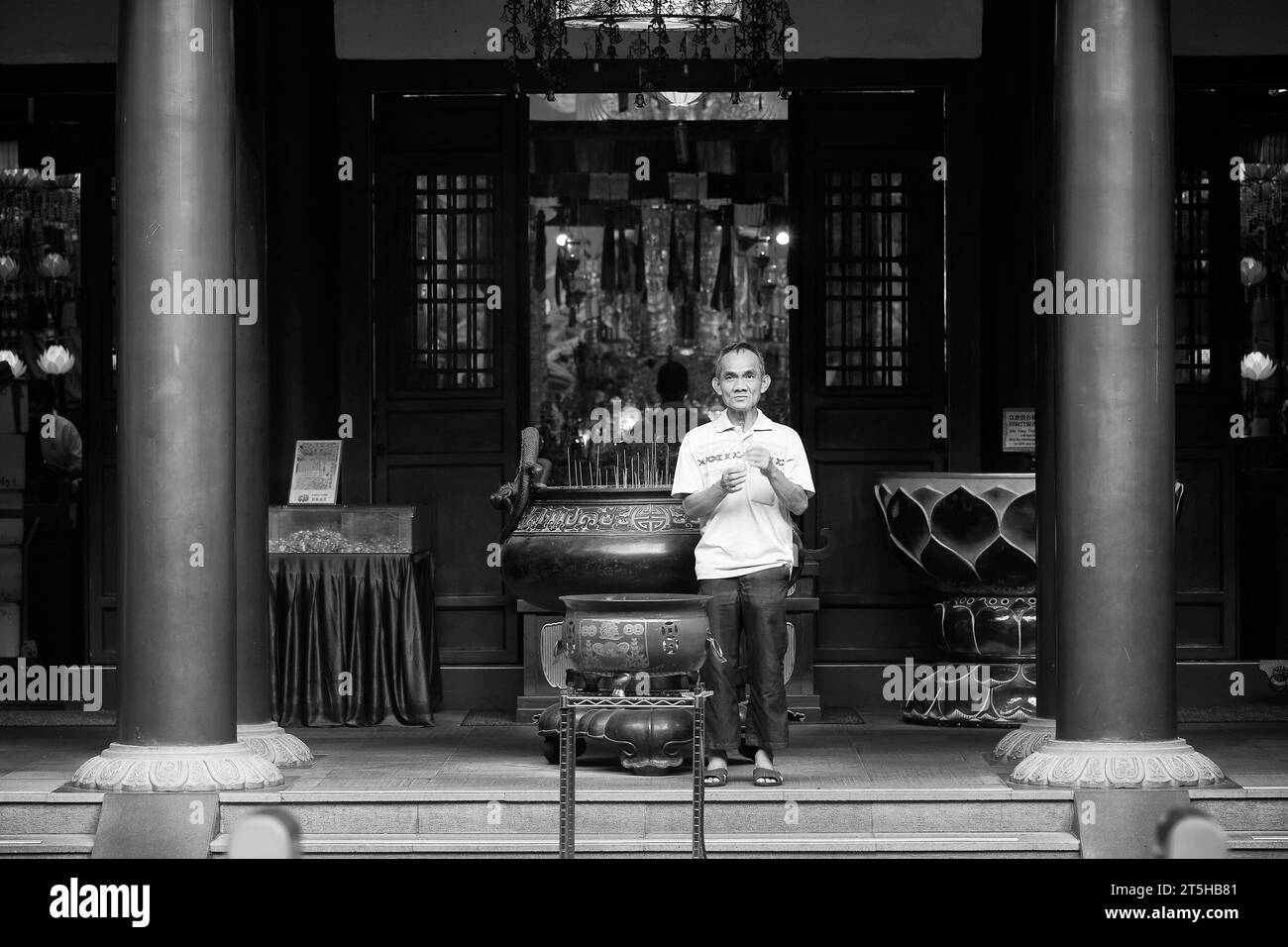 Black And White Photo Of An Asian Man Holding Incense, Standing At The Entrance To The Buddha Tooth Relic Temple, Singapore. Stock Photohttps://www.alamy.com/image-license-details/?v=1https://www.alamy.com/black-and-white-photo-of-an-asian-man-holding-incense-standing-at-the-entrance-to-the-buddha-tooth-relic-temple-singapore-image571397457.html
Black And White Photo Of An Asian Man Holding Incense, Standing At The Entrance To The Buddha Tooth Relic Temple, Singapore. Stock Photohttps://www.alamy.com/image-license-details/?v=1https://www.alamy.com/black-and-white-photo-of-an-asian-man-holding-incense-standing-at-the-entrance-to-the-buddha-tooth-relic-temple-singapore-image571397457.htmlRM2T5HB81–Black And White Photo Of An Asian Man Holding Incense, Standing At The Entrance To The Buddha Tooth Relic Temple, Singapore.
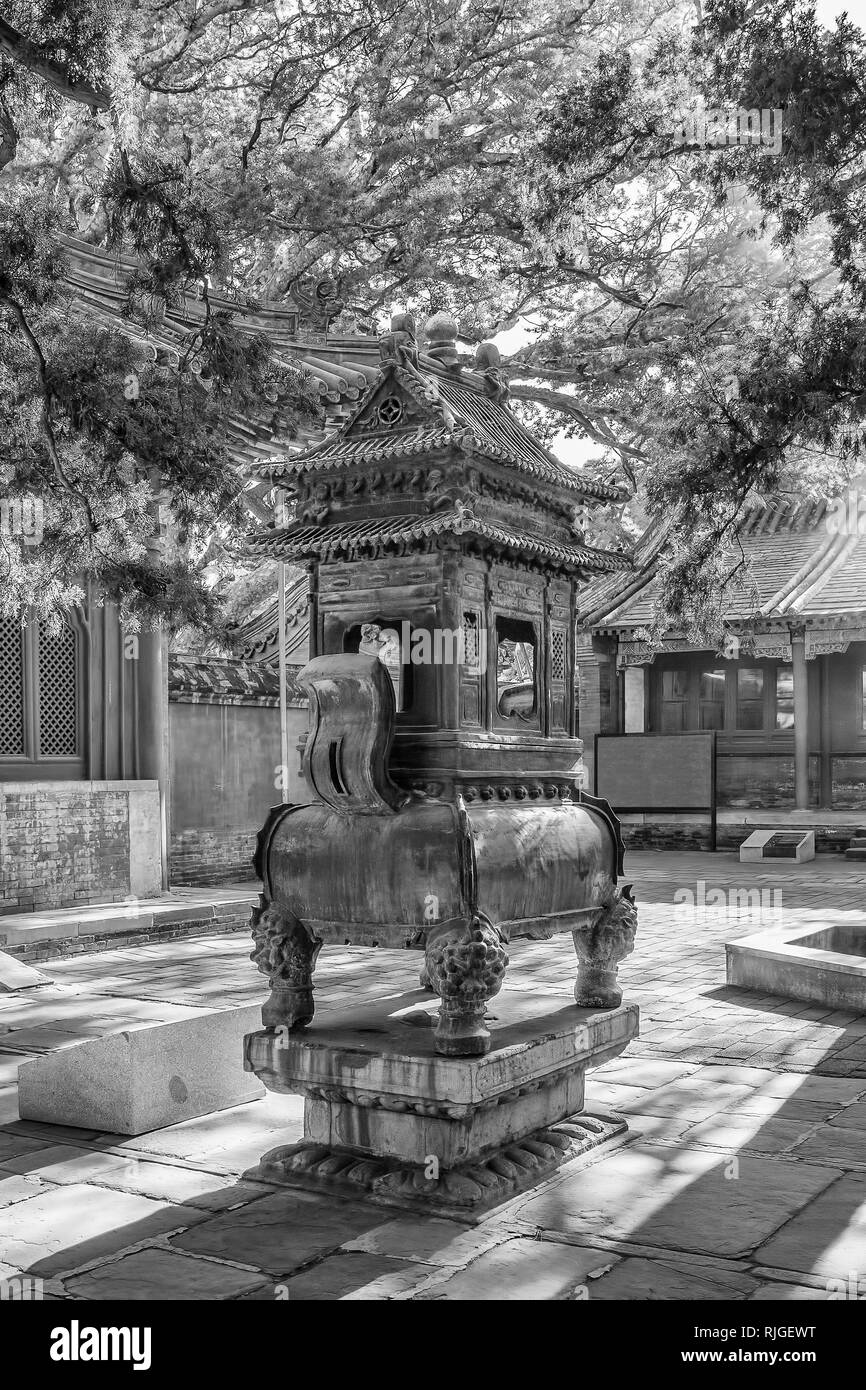 Iron altar at tranquil Jietai Buddhist temple, Beijing, China Stock Photohttps://www.alamy.com/image-license-details/?v=1https://www.alamy.com/iron-altar-at-tranquil-jietai-buddhist-temple-beijing-china-image235161524.html
Iron altar at tranquil Jietai Buddhist temple, Beijing, China Stock Photohttps://www.alamy.com/image-license-details/?v=1https://www.alamy.com/iron-altar-at-tranquil-jietai-buddhist-temple-beijing-china-image235161524.htmlRFRJGEWT–Iron altar at tranquil Jietai Buddhist temple, Beijing, China
 Worshippers of ethnic minority light INCENSE at the Buddhist YUANTONG TEMPLE in KUNMING - YUNNAN, CHINA Stock Photohttps://www.alamy.com/image-license-details/?v=1https://www.alamy.com/worshippers-of-ethnic-minority-light-incense-at-the-buddhist-yuantong-temple-in-kunming-yunnan-china-image211810571.html
Worshippers of ethnic minority light INCENSE at the Buddhist YUANTONG TEMPLE in KUNMING - YUNNAN, CHINA Stock Photohttps://www.alamy.com/image-license-details/?v=1https://www.alamy.com/worshippers-of-ethnic-minority-light-incense-at-the-buddhist-yuantong-temple-in-kunming-yunnan-china-image211810571.htmlRMP8GPF7–Worshippers of ethnic minority light INCENSE at the Buddhist YUANTONG TEMPLE in KUNMING - YUNNAN, CHINA
 The Big Temple at Po Lin Buddhist Monastery Lantau Island Hong Kong 1979 Stock Photohttps://www.alamy.com/image-license-details/?v=1https://www.alamy.com/stock-photo-the-big-temple-at-po-lin-buddhist-monastery-lantau-island-hong-kong-19122079.html
The Big Temple at Po Lin Buddhist Monastery Lantau Island Hong Kong 1979 Stock Photohttps://www.alamy.com/image-license-details/?v=1https://www.alamy.com/stock-photo-the-big-temple-at-po-lin-buddhist-monastery-lantau-island-hong-kong-19122079.htmlRMB332BB–The Big Temple at Po Lin Buddhist Monastery Lantau Island Hong Kong 1979
RF2Y7YX99–China temple historical building oriental style Chinese architecture holy sacred place ancient design icon set
RFEGD4JD–Asia logo design template. Temple or religion icon.
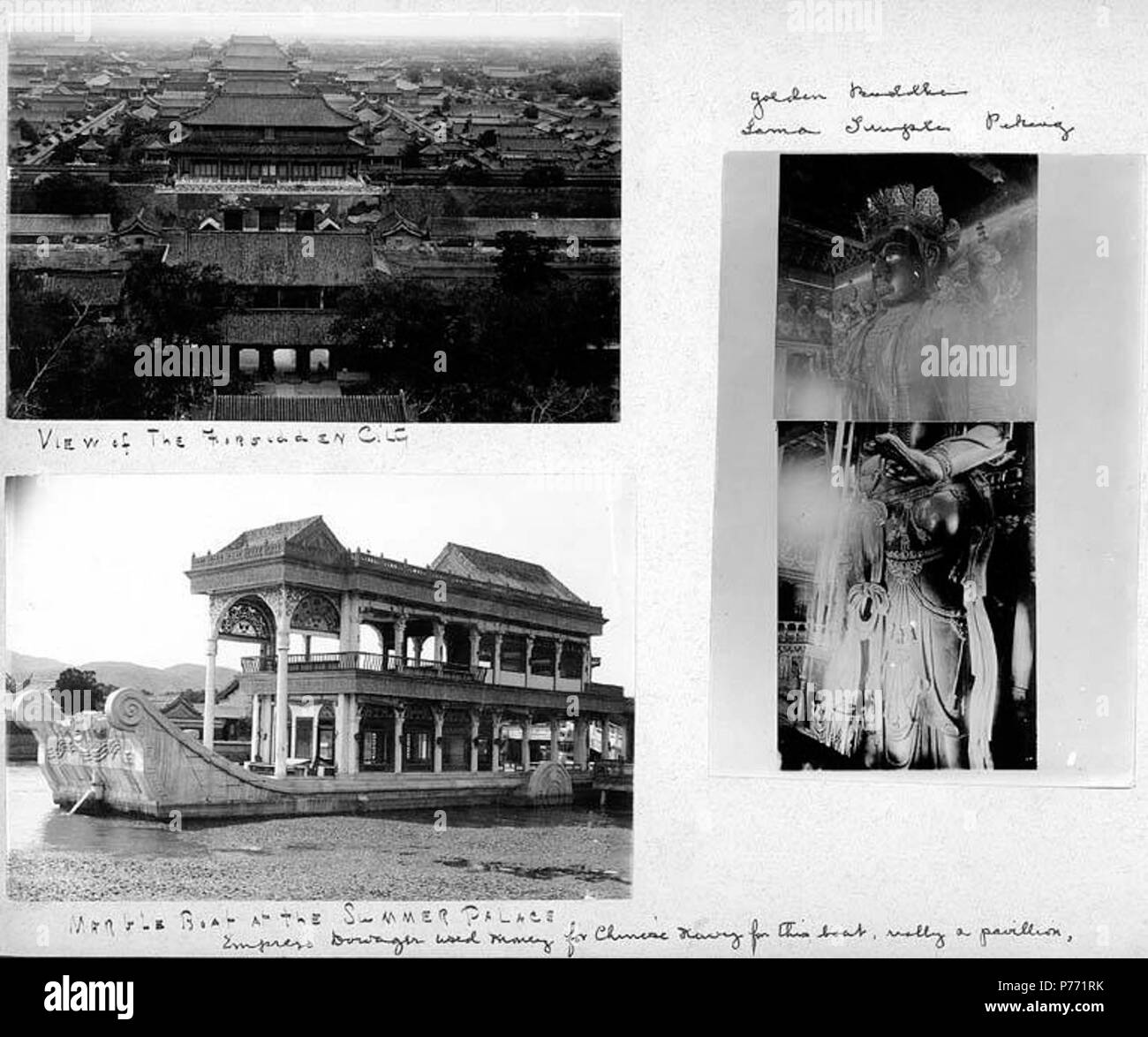 . English: 7.29 Peking scenes, ca. 1903 . English: Captions on album page: View of the Forbidden City; Golden Buddha, Lama Temple, Peking; Marble boat at the Summer Palace, Empress Dowager used money for Chinese navy for this boat, really a pavillion . PH Coll 241.B29a-c Subjects (LCTGM): Castles & palaces--China--Beijing; Buddhas--China--Beijing; Buddhist temples--China--Beijing; Pavilions--China--Beijing Subjects (LCSH): Forbidden City (Beijing, China); Gautama Buddha--Art; Sculpture, Buddhist--China--Beijing; Buddhist art and symbolism--China--Beijing; Yong he gong (Beijing, China); Yihe Yu Stock Photohttps://www.alamy.com/image-license-details/?v=1https://www.alamy.com/english-729-peking-scenes-ca-1903-english-captions-on-album-page-view-of-the-forbidden-city-golden-buddha-lama-temple-peking-marble-boat-at-the-summer-palace-empress-dowager-used-money-for-chinese-navy-for-this-boat-really-a-pavillion-ph-coll-241b29a-c-subjects-lctgm-castles-palaces-china-beijing-buddhas-china-beijing-buddhist-temples-china-beijing-pavilions-china-beijing-subjects-lcsh-forbidden-city-beijing-china-gautama-buddha-art-sculpture-buddhist-china-beijing-buddhist-art-and-symbolism-china-beijing-yong-he-gong-beijing-china-yihe-yu-image210982119.html
. English: 7.29 Peking scenes, ca. 1903 . English: Captions on album page: View of the Forbidden City; Golden Buddha, Lama Temple, Peking; Marble boat at the Summer Palace, Empress Dowager used money for Chinese navy for this boat, really a pavillion . PH Coll 241.B29a-c Subjects (LCTGM): Castles & palaces--China--Beijing; Buddhas--China--Beijing; Buddhist temples--China--Beijing; Pavilions--China--Beijing Subjects (LCSH): Forbidden City (Beijing, China); Gautama Buddha--Art; Sculpture, Buddhist--China--Beijing; Buddhist art and symbolism--China--Beijing; Yong he gong (Beijing, China); Yihe Yu Stock Photohttps://www.alamy.com/image-license-details/?v=1https://www.alamy.com/english-729-peking-scenes-ca-1903-english-captions-on-album-page-view-of-the-forbidden-city-golden-buddha-lama-temple-peking-marble-boat-at-the-summer-palace-empress-dowager-used-money-for-chinese-navy-for-this-boat-really-a-pavillion-ph-coll-241b29a-c-subjects-lctgm-castles-palaces-china-beijing-buddhas-china-beijing-buddhist-temples-china-beijing-pavilions-china-beijing-subjects-lcsh-forbidden-city-beijing-china-gautama-buddha-art-sculpture-buddhist-china-beijing-buddhist-art-and-symbolism-china-beijing-yong-he-gong-beijing-china-yihe-yu-image210982119.htmlRMP771RK–. English: 7.29 Peking scenes, ca. 1903 . English: Captions on album page: View of the Forbidden City; Golden Buddha, Lama Temple, Peking; Marble boat at the Summer Palace, Empress Dowager used money for Chinese navy for this boat, really a pavillion . PH Coll 241.B29a-c Subjects (LCTGM): Castles & palaces--China--Beijing; Buddhas--China--Beijing; Buddhist temples--China--Beijing; Pavilions--China--Beijing Subjects (LCSH): Forbidden City (Beijing, China); Gautama Buddha--Art; Sculpture, Buddhist--China--Beijing; Buddhist art and symbolism--China--Beijing; Yong he gong (Beijing, China); Yihe Yu
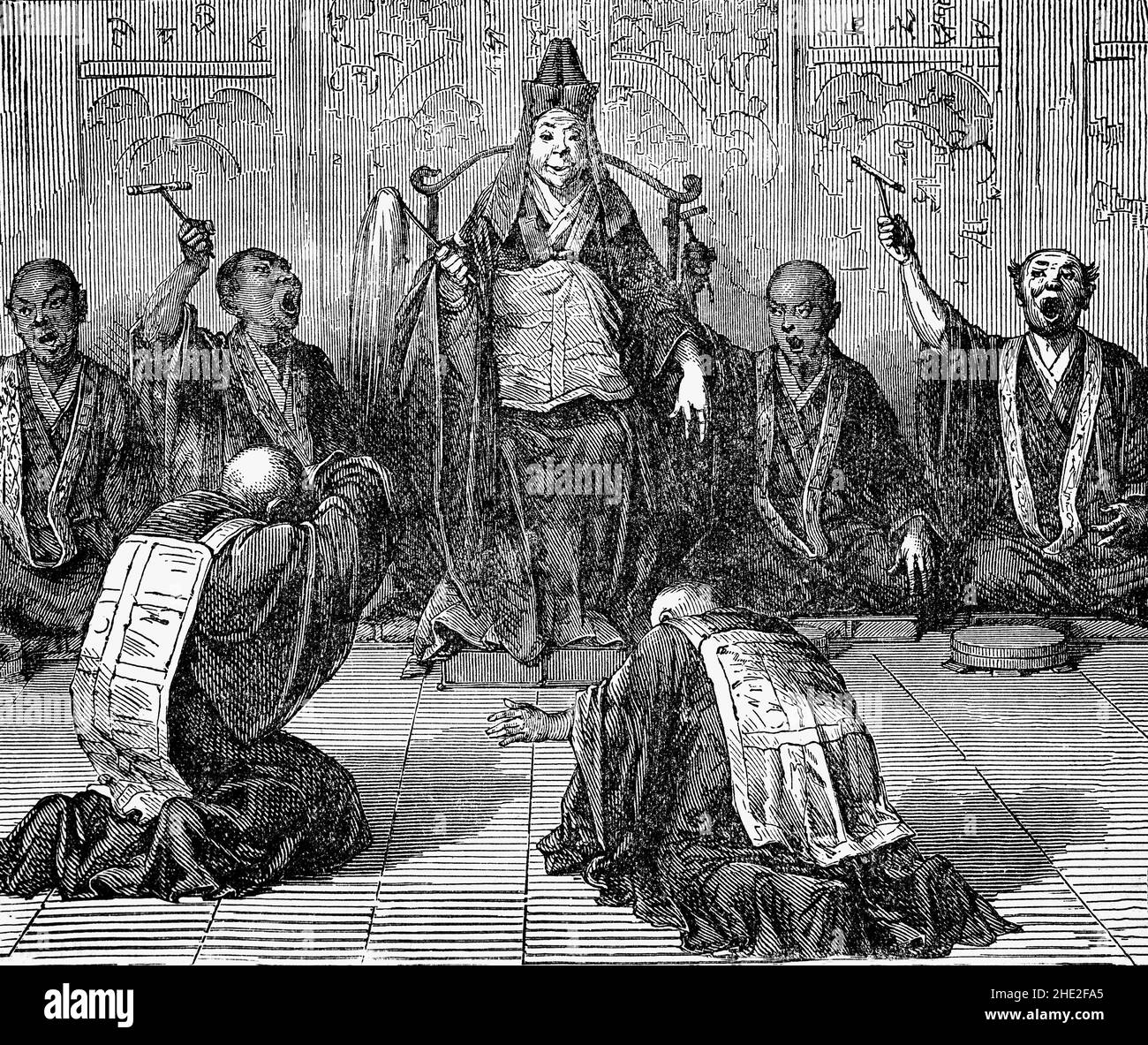 A late 19th Century illustration of Japanese Buddhist priests. Practiced in Japan since about the sixth century CE, it has given birth to numerous new Buddhist schools, many of which trace themselves to Chinese Buddhist traditions. Japanese Buddhism had a major influence on Japanese society and culture and remains an influential aspect to this day Stock Photohttps://www.alamy.com/image-license-details/?v=1https://www.alamy.com/a-late-19th-century-illustration-of-japanese-buddhist-priests-practiced-in-japan-since-about-the-sixth-century-ce-it-has-given-birth-to-numerous-new-buddhist-schools-many-of-which-trace-themselves-to-chinese-buddhist-traditions-japanese-buddhism-had-a-major-influence-on-japanese-society-and-culture-and-remains-an-influential-aspect-to-this-day-image456130701.html
A late 19th Century illustration of Japanese Buddhist priests. Practiced in Japan since about the sixth century CE, it has given birth to numerous new Buddhist schools, many of which trace themselves to Chinese Buddhist traditions. Japanese Buddhism had a major influence on Japanese society and culture and remains an influential aspect to this day Stock Photohttps://www.alamy.com/image-license-details/?v=1https://www.alamy.com/a-late-19th-century-illustration-of-japanese-buddhist-priests-practiced-in-japan-since-about-the-sixth-century-ce-it-has-given-birth-to-numerous-new-buddhist-schools-many-of-which-trace-themselves-to-chinese-buddhist-traditions-japanese-buddhism-had-a-major-influence-on-japanese-society-and-culture-and-remains-an-influential-aspect-to-this-day-image456130701.htmlRM2HE2FA5–A late 19th Century illustration of Japanese Buddhist priests. Practiced in Japan since about the sixth century CE, it has given birth to numerous new Buddhist schools, many of which trace themselves to Chinese Buddhist traditions. Japanese Buddhism had a major influence on Japanese society and culture and remains an influential aspect to this day
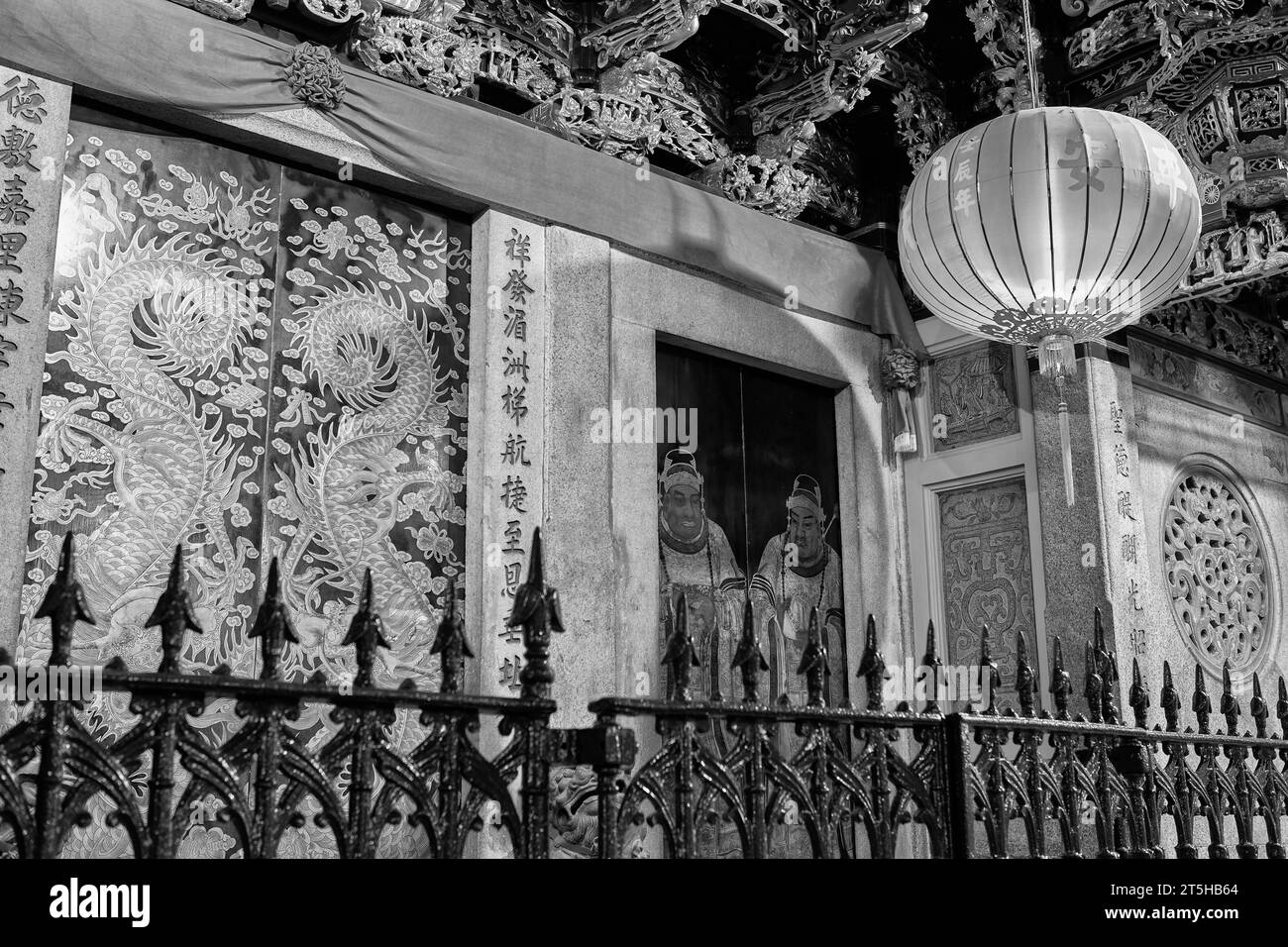 Black And White Photo Of The Entrance To The Thian Hock Keng Temple After Dark, Telok Ayer Street, Singapore. Stock Photohttps://www.alamy.com/image-license-details/?v=1https://www.alamy.com/black-and-white-photo-of-the-entrance-to-the-thian-hock-keng-temple-after-dark-telok-ayer-street-singapore-image571397404.html
Black And White Photo Of The Entrance To The Thian Hock Keng Temple After Dark, Telok Ayer Street, Singapore. Stock Photohttps://www.alamy.com/image-license-details/?v=1https://www.alamy.com/black-and-white-photo-of-the-entrance-to-the-thian-hock-keng-temple-after-dark-telok-ayer-street-singapore-image571397404.htmlRM2T5HB64–Black And White Photo Of The Entrance To The Thian Hock Keng Temple After Dark, Telok Ayer Street, Singapore.
 Incense burning at the Lama Temple in Beijing China in Black and White Stock Photohttps://www.alamy.com/image-license-details/?v=1https://www.alamy.com/incense-burning-at-the-lama-temple-in-beijing-china-in-black-and-white-image7121781.html
Incense burning at the Lama Temple in Beijing China in Black and White Stock Photohttps://www.alamy.com/image-license-details/?v=1https://www.alamy.com/incense-burning-at-the-lama-temple-in-beijing-china-in-black-and-white-image7121781.htmlRMA9YBK6–Incense burning at the Lama Temple in Beijing China in Black and White
 PENANG, MALAYSIA, DECEMBER 20 2017: Kek Lok Si temple, a Chinese Buddhist temple situated in Air Itam with moderne Skyline of Penang Stock Photohttps://www.alamy.com/image-license-details/?v=1https://www.alamy.com/stock-photo-penang-malaysia-december-20-2017-kek-lok-si-temple-a-chinese-buddhist-175516796.html
PENANG, MALAYSIA, DECEMBER 20 2017: Kek Lok Si temple, a Chinese Buddhist temple situated in Air Itam with moderne Skyline of Penang Stock Photohttps://www.alamy.com/image-license-details/?v=1https://www.alamy.com/stock-photo-penang-malaysia-december-20-2017-kek-lok-si-temple-a-chinese-buddhist-175516796.htmlRFM5FDD0–PENANG, MALAYSIA, DECEMBER 20 2017: Kek Lok Si temple, a Chinese Buddhist temple situated in Air Itam with moderne Skyline of Penang
 Chinese Buddhist Temple Stock Photohttps://www.alamy.com/image-license-details/?v=1https://www.alamy.com/chinese-buddhist-temple-image259745192.html
Chinese Buddhist Temple Stock Photohttps://www.alamy.com/image-license-details/?v=1https://www.alamy.com/chinese-buddhist-temple-image259745192.htmlRMW2GBJ0–Chinese Buddhist Temple
 China, Shanxi Province, Datong, Ancient Buddhist sculptures within Cave 18 inside Yungang Buddha Caves Stock Photohttps://www.alamy.com/image-license-details/?v=1https://www.alamy.com/stock-photo-china-shanxi-province-datong-ancient-buddhist-sculptures-within-cave-139144118.html
China, Shanxi Province, Datong, Ancient Buddhist sculptures within Cave 18 inside Yungang Buddha Caves Stock Photohttps://www.alamy.com/image-license-details/?v=1https://www.alamy.com/stock-photo-china-shanxi-province-datong-ancient-buddhist-sculptures-within-cave-139144118.htmlRMJ2AFMP–China, Shanxi Province, Datong, Ancient Buddhist sculptures within Cave 18 inside Yungang Buddha Caves
 Malaysia / China: Carving of the Diamond King Mo-Li Hai, Guardian of the West, depicting his role in the 16th Century Ming Dynasty novel Fengshen Yanyi ('Investiture of the Gods'). From Ping Sien Si Temple, Pasir Panjang Laut. Photo by Anandajoti (CC BY 2.0). A Taoist deity, Mo-Li Hai was one of the Four Diamond Kings, and Guardian of the West. He is often depicted with a blue face and holding a guitar, with which he can destroy his enemies through musical fire. He also plays a small role in the classic Ming Dynasty novel 'Fengshen Yanyi', alongside the other Diamond Kings. Stock Photohttps://www.alamy.com/image-license-details/?v=1https://www.alamy.com/malaysia-china-carving-of-the-diamond-king-mo-li-hai-guardian-of-the-west-depicting-his-role-in-the-16th-century-ming-dynasty-novel-fengshen-yanyi-investiture-of-the-gods-from-ping-sien-si-temple-pasir-panjang-laut-photo-by-anandajoti-cc-by-20-a-taoist-deity-mo-li-hai-was-one-of-the-four-diamond-kings-and-guardian-of-the-west-he-is-often-depicted-with-a-blue-face-and-holding-a-guitar-with-which-he-can-destroy-his-enemies-through-musical-fire-he-also-plays-a-small-role-in-the-classic-ming-dynasty-novel-fengshen-yanyi-alongside-the-other-diamond-kings-image344278345.html
Malaysia / China: Carving of the Diamond King Mo-Li Hai, Guardian of the West, depicting his role in the 16th Century Ming Dynasty novel Fengshen Yanyi ('Investiture of the Gods'). From Ping Sien Si Temple, Pasir Panjang Laut. Photo by Anandajoti (CC BY 2.0). A Taoist deity, Mo-Li Hai was one of the Four Diamond Kings, and Guardian of the West. He is often depicted with a blue face and holding a guitar, with which he can destroy his enemies through musical fire. He also plays a small role in the classic Ming Dynasty novel 'Fengshen Yanyi', alongside the other Diamond Kings. Stock Photohttps://www.alamy.com/image-license-details/?v=1https://www.alamy.com/malaysia-china-carving-of-the-diamond-king-mo-li-hai-guardian-of-the-west-depicting-his-role-in-the-16th-century-ming-dynasty-novel-fengshen-yanyi-investiture-of-the-gods-from-ping-sien-si-temple-pasir-panjang-laut-photo-by-anandajoti-cc-by-20-a-taoist-deity-mo-li-hai-was-one-of-the-four-diamond-kings-and-guardian-of-the-west-he-is-often-depicted-with-a-blue-face-and-holding-a-guitar-with-which-he-can-destroy-his-enemies-through-musical-fire-he-also-plays-a-small-role-in-the-classic-ming-dynasty-novel-fengshen-yanyi-alongside-the-other-diamond-kings-image344278345.htmlRM2B036F5–Malaysia / China: Carving of the Diamond King Mo-Li Hai, Guardian of the West, depicting his role in the 16th Century Ming Dynasty novel Fengshen Yanyi ('Investiture of the Gods'). From Ping Sien Si Temple, Pasir Panjang Laut. Photo by Anandajoti (CC BY 2.0). A Taoist deity, Mo-Li Hai was one of the Four Diamond Kings, and Guardian of the West. He is often depicted with a blue face and holding a guitar, with which he can destroy his enemies through musical fire. He also plays a small role in the classic Ming Dynasty novel 'Fengshen Yanyi', alongside the other Diamond Kings.
 Chinese Buddhist Temple Stock Photohttps://www.alamy.com/image-license-details/?v=1https://www.alamy.com/chinese-buddhist-temple-image264523080.html
Chinese Buddhist Temple Stock Photohttps://www.alamy.com/image-license-details/?v=1https://www.alamy.com/chinese-buddhist-temple-image264523080.htmlRMWAA1TT–Chinese Buddhist Temple
 Malaysia / China: Carving of Zheng Lun, depicting his role in the 16th Century Ming Dynasty novel Fengshen Yanyi ('Investiture of the Gods'). From Ping Sien Si Temple, Pasir Panjang Laut. Photo by Anandajoti (CC BY 2.0). Zheng Lun is a character featured in the classic Ming Dynasty novel 'Fengshen Yanyi'. Originally the head student of Due Zhenren of the Western Kunlun Mountains, Zheng Lun was destined to one day assist in the founding of a new dynasty and then ascend to the rank of god. He was described as having hair like golden noodles, with a face like that of a purple plum. Stock Photohttps://www.alamy.com/image-license-details/?v=1https://www.alamy.com/malaysia-china-carving-of-zheng-lun-depicting-his-role-in-the-16th-century-ming-dynasty-novel-fengshen-yanyi-investiture-of-the-gods-from-ping-sien-si-temple-pasir-panjang-laut-photo-by-anandajoti-cc-by-20-zheng-lun-is-a-character-featured-in-the-classic-ming-dynasty-novel-fengshen-yanyi-originally-the-head-student-of-due-zhenren-of-the-western-kunlun-mountains-zheng-lun-was-destined-to-one-day-assist-in-the-founding-of-a-new-dynasty-and-then-ascend-to-the-rank-of-god-he-was-described-as-having-hair-like-golden-noodles-with-a-face-like-that-of-a-purple-plum-image344278149.html
Malaysia / China: Carving of Zheng Lun, depicting his role in the 16th Century Ming Dynasty novel Fengshen Yanyi ('Investiture of the Gods'). From Ping Sien Si Temple, Pasir Panjang Laut. Photo by Anandajoti (CC BY 2.0). Zheng Lun is a character featured in the classic Ming Dynasty novel 'Fengshen Yanyi'. Originally the head student of Due Zhenren of the Western Kunlun Mountains, Zheng Lun was destined to one day assist in the founding of a new dynasty and then ascend to the rank of god. He was described as having hair like golden noodles, with a face like that of a purple plum. Stock Photohttps://www.alamy.com/image-license-details/?v=1https://www.alamy.com/malaysia-china-carving-of-zheng-lun-depicting-his-role-in-the-16th-century-ming-dynasty-novel-fengshen-yanyi-investiture-of-the-gods-from-ping-sien-si-temple-pasir-panjang-laut-photo-by-anandajoti-cc-by-20-zheng-lun-is-a-character-featured-in-the-classic-ming-dynasty-novel-fengshen-yanyi-originally-the-head-student-of-due-zhenren-of-the-western-kunlun-mountains-zheng-lun-was-destined-to-one-day-assist-in-the-founding-of-a-new-dynasty-and-then-ascend-to-the-rank-of-god-he-was-described-as-having-hair-like-golden-noodles-with-a-face-like-that-of-a-purple-plum-image344278149.htmlRM2B03685–Malaysia / China: Carving of Zheng Lun, depicting his role in the 16th Century Ming Dynasty novel Fengshen Yanyi ('Investiture of the Gods'). From Ping Sien Si Temple, Pasir Panjang Laut. Photo by Anandajoti (CC BY 2.0). Zheng Lun is a character featured in the classic Ming Dynasty novel 'Fengshen Yanyi'. Originally the head student of Due Zhenren of the Western Kunlun Mountains, Zheng Lun was destined to one day assist in the founding of a new dynasty and then ascend to the rank of god. He was described as having hair like golden noodles, with a face like that of a purple plum.
 Pagoda at Zhen Ru Temple, Shanghai Stock Photohttps://www.alamy.com/image-license-details/?v=1https://www.alamy.com/pagoda-at-zhen-ru-temple-shanghai-image62340721.html
Pagoda at Zhen Ru Temple, Shanghai Stock Photohttps://www.alamy.com/image-license-details/?v=1https://www.alamy.com/pagoda-at-zhen-ru-temple-shanghai-image62340721.htmlRMDHBT69–Pagoda at Zhen Ru Temple, Shanghai
 Chinese Buddhist Temple (LOC) Stock Photohttps://www.alamy.com/image-license-details/?v=1https://www.alamy.com/stock-photo-chinese-buddhist-temple-loc-55075380.html
Chinese Buddhist Temple (LOC) Stock Photohttps://www.alamy.com/image-license-details/?v=1https://www.alamy.com/stock-photo-chinese-buddhist-temple-loc-55075380.htmlRMD5GW5T–Chinese Buddhist Temple (LOC)
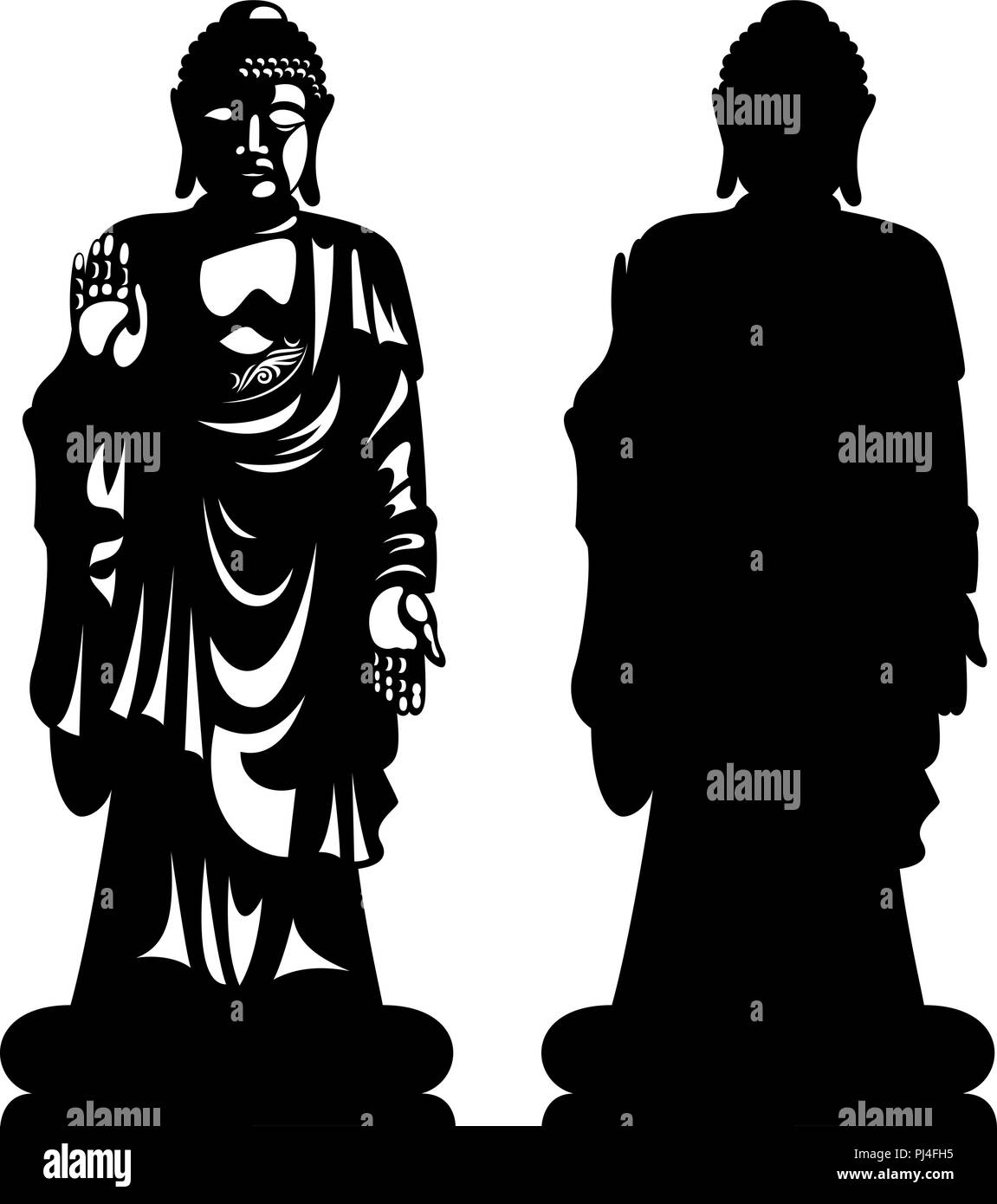 Statue of Buddha. Asian religious symbol. Vector silhouette. World landmark Stock Vectorhttps://www.alamy.com/image-license-details/?v=1https://www.alamy.com/statue-of-buddha-asian-religious-symbol-vector-silhouette-world-landmark-image217688273.html
Statue of Buddha. Asian religious symbol. Vector silhouette. World landmark Stock Vectorhttps://www.alamy.com/image-license-details/?v=1https://www.alamy.com/statue-of-buddha-asian-religious-symbol-vector-silhouette-world-landmark-image217688273.htmlRFPJ4FH5–Statue of Buddha. Asian religious symbol. Vector silhouette. World landmark
 Chinese Buddhist Temple LCCN2014694559 Stock Photohttps://www.alamy.com/image-license-details/?v=1https://www.alamy.com/stock-photo-chinese-buddhist-temple-lccn2014694559-176672300.html
Chinese Buddhist Temple LCCN2014694559 Stock Photohttps://www.alamy.com/image-license-details/?v=1https://www.alamy.com/stock-photo-chinese-buddhist-temple-lccn2014694559-176672300.htmlRMM7C390–Chinese Buddhist Temple LCCN2014694559
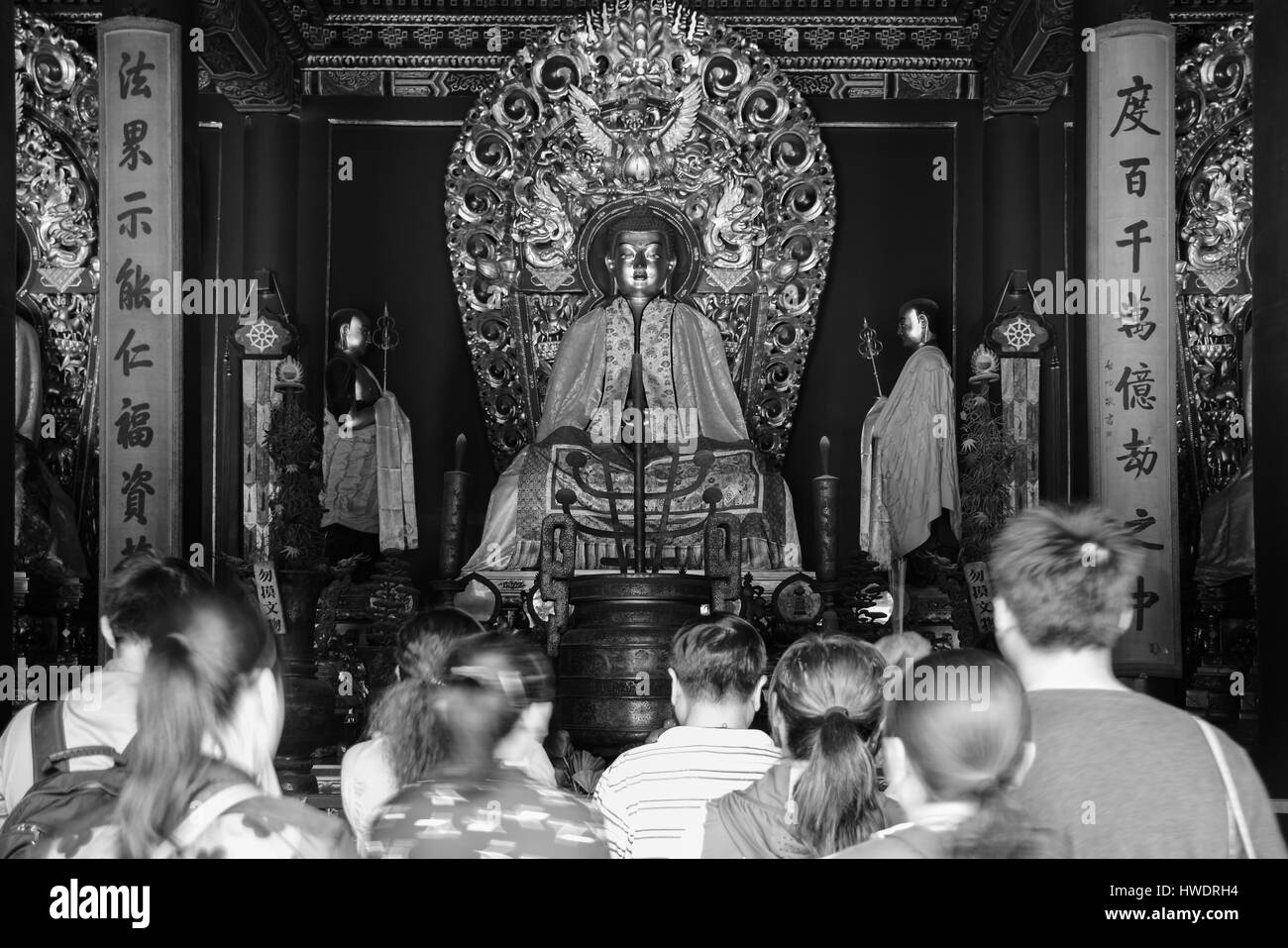 The buddha image; color in black and white, at the Tibetan Buddhist Lama temple in Beijing China Stock Photohttps://www.alamy.com/image-license-details/?v=1https://www.alamy.com/stock-photo-the-buddha-image-color-in-black-and-white-at-the-tibetan-buddhist-136142864.html
The buddha image; color in black and white, at the Tibetan Buddhist Lama temple in Beijing China Stock Photohttps://www.alamy.com/image-license-details/?v=1https://www.alamy.com/stock-photo-the-buddha-image-color-in-black-and-white-at-the-tibetan-buddhist-136142864.htmlRFHWDRH4–The buddha image; color in black and white, at the Tibetan Buddhist Lama temple in Beijing China
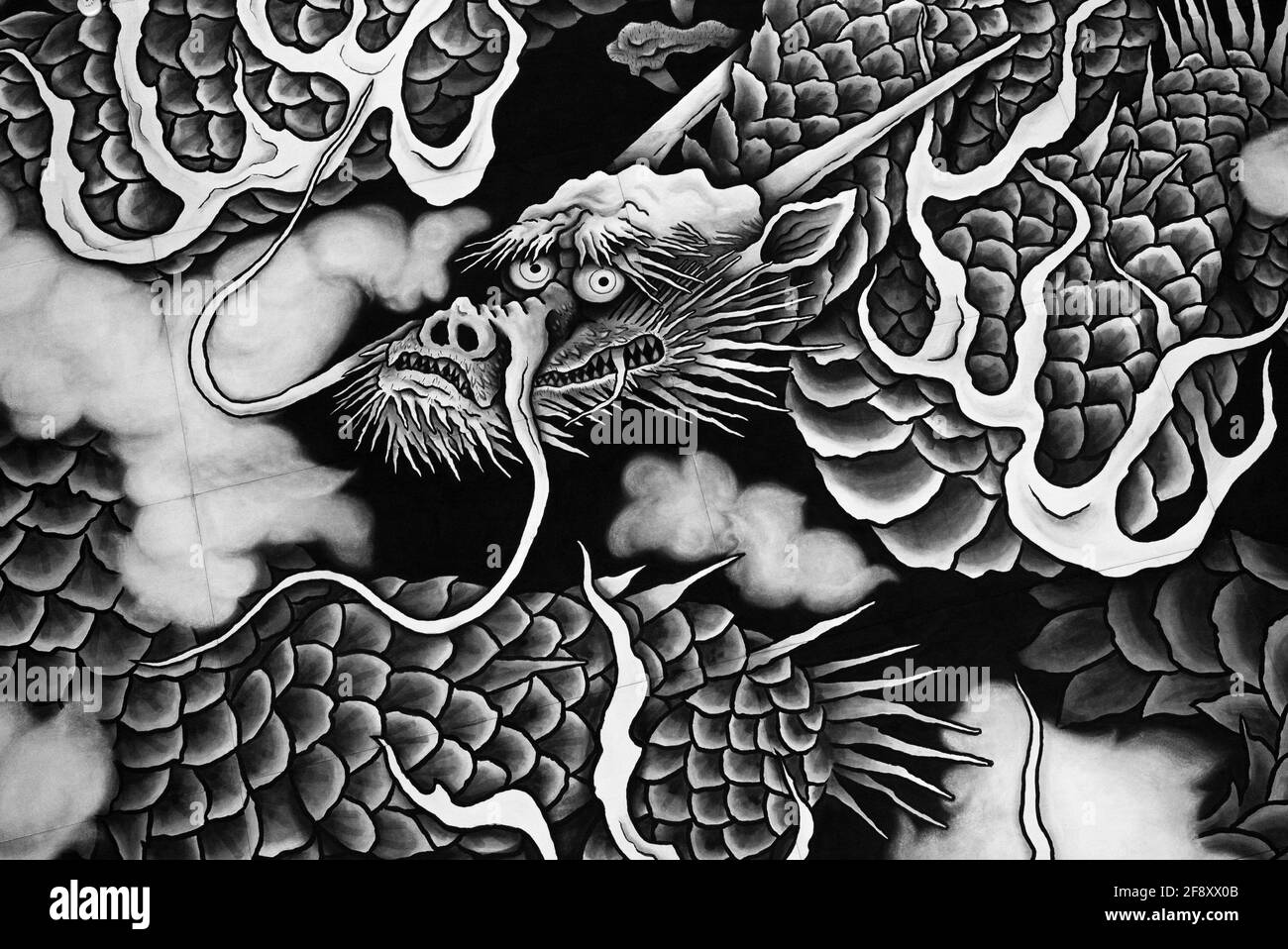 Dragon painting at Kencho-ji Zen Buddhist Temple. Kenchoji. Junsaku Koizumi. Unryu, Dragon amid clouds. Kamakura, Japan. Dragon ball background. Stock Photohttps://www.alamy.com/image-license-details/?v=1https://www.alamy.com/dragon-painting-at-kencho-ji-zen-buddhist-temple-kenchoji-junsaku-koizumi-unryu-dragon-amid-clouds-kamakura-japan-dragon-ball-background-image418557227.html
Dragon painting at Kencho-ji Zen Buddhist Temple. Kenchoji. Junsaku Koizumi. Unryu, Dragon amid clouds. Kamakura, Japan. Dragon ball background. Stock Photohttps://www.alamy.com/image-license-details/?v=1https://www.alamy.com/dragon-painting-at-kencho-ji-zen-buddhist-temple-kenchoji-junsaku-koizumi-unryu-dragon-amid-clouds-kamakura-japan-dragon-ball-background-image418557227.htmlRF2F8XX0B–Dragon painting at Kencho-ji Zen Buddhist Temple. Kenchoji. Junsaku Koizumi. Unryu, Dragon amid clouds. Kamakura, Japan. Dragon ball background.
 Thailand: Two Buddhist monks with a pupil and servants, late 19th century. Nearly 95 percent of the Thai population are Theravada Buddhists, though many would argue that Siamese Buddhism has integrated with animist folk beliefs as well as Chinese religions. Thai Buddhism was based on the religious movement founded in the 6th century BCE by Siddhartha, later known as the Buddha, who urged the world to relinquish the extremes of sensuality and self-mortification and follow the enlightened Middle Way. Theravada Buddhism was made the state religion in Siam after the establishment of Sukhothai. Stock Photohttps://www.alamy.com/image-license-details/?v=1https://www.alamy.com/thailand-two-buddhist-monks-with-a-pupil-and-servants-late-19th-century-nearly-95-percent-of-the-thai-population-are-theravada-buddhists-though-many-would-argue-that-siamese-buddhism-has-integrated-with-animist-folk-beliefs-as-well-as-chinese-religions-thai-buddhism-was-based-on-the-religious-movement-founded-in-the-6th-century-bce-by-siddhartha-later-known-as-the-buddha-who-urged-the-world-to-relinquish-the-extremes-of-sensuality-and-self-mortification-and-follow-the-enlightened-middle-way-theravada-buddhism-was-made-the-state-religion-in-siam-after-the-establishment-of-sukhothai-image344230499.html
Thailand: Two Buddhist monks with a pupil and servants, late 19th century. Nearly 95 percent of the Thai population are Theravada Buddhists, though many would argue that Siamese Buddhism has integrated with animist folk beliefs as well as Chinese religions. Thai Buddhism was based on the religious movement founded in the 6th century BCE by Siddhartha, later known as the Buddha, who urged the world to relinquish the extremes of sensuality and self-mortification and follow the enlightened Middle Way. Theravada Buddhism was made the state religion in Siam after the establishment of Sukhothai. Stock Photohttps://www.alamy.com/image-license-details/?v=1https://www.alamy.com/thailand-two-buddhist-monks-with-a-pupil-and-servants-late-19th-century-nearly-95-percent-of-the-thai-population-are-theravada-buddhists-though-many-would-argue-that-siamese-buddhism-has-integrated-with-animist-folk-beliefs-as-well-as-chinese-religions-thai-buddhism-was-based-on-the-religious-movement-founded-in-the-6th-century-bce-by-siddhartha-later-known-as-the-buddha-who-urged-the-world-to-relinquish-the-extremes-of-sensuality-and-self-mortification-and-follow-the-enlightened-middle-way-theravada-buddhism-was-made-the-state-religion-in-siam-after-the-establishment-of-sukhothai-image344230499.htmlRM2B011EB–Thailand: Two Buddhist monks with a pupil and servants, late 19th century. Nearly 95 percent of the Thai population are Theravada Buddhists, though many would argue that Siamese Buddhism has integrated with animist folk beliefs as well as Chinese religions. Thai Buddhism was based on the religious movement founded in the 6th century BCE by Siddhartha, later known as the Buddha, who urged the world to relinquish the extremes of sensuality and self-mortification and follow the enlightened Middle Way. Theravada Buddhism was made the state religion in Siam after the establishment of Sukhothai.
RF2Y7YXD2–Chinese oriental holy sacred architecture building place China temple Buddhist worship religion tourism destination design set icon
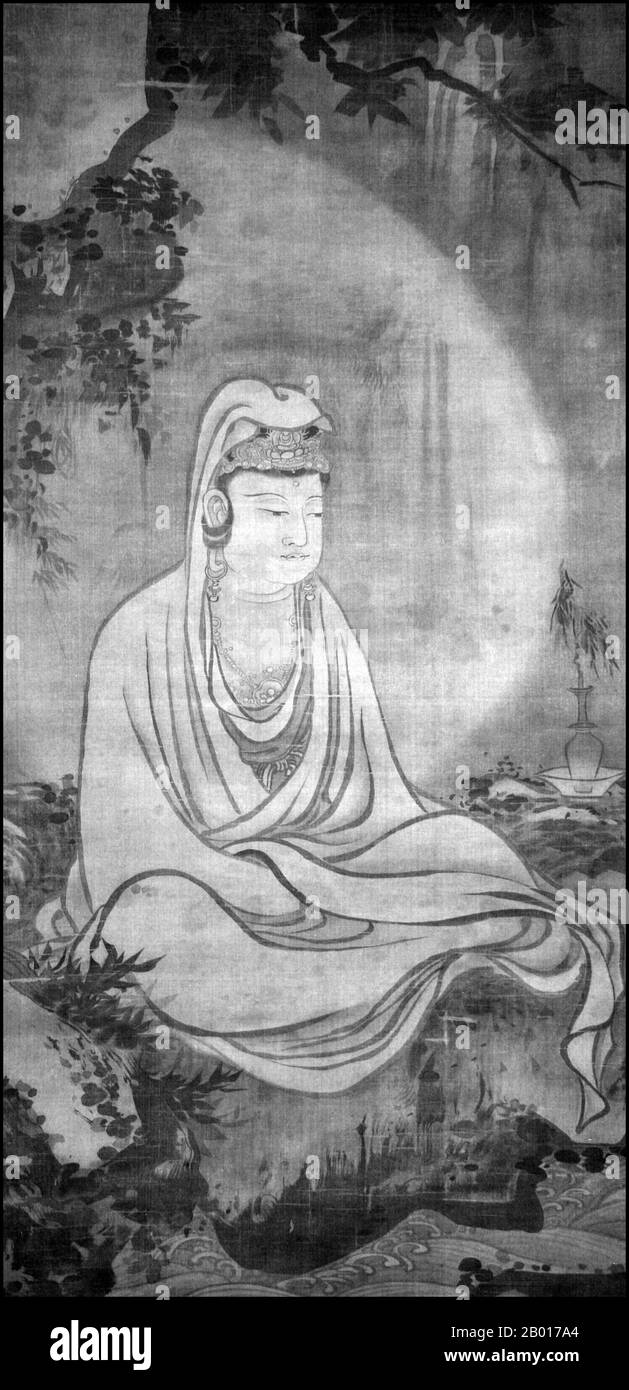 China/Japan: Guan Yin in white robe. Hanging scroll painting by Mu-ch'i (c. 1210-1269), preserved at Daitokuji temple in Kyoto, Japan, early Ming copy. Guan Yin (Guanyin), also known as Kuan Yin and Guanshiyin, is the bodhisattva of mercy and compassion in Buddhism. The East Asian equivalent of Avalokitesvara, she is particularly popular in Chinese folk religion. She was called the 'goddess of mercy' by Jesuit missionaries in China. She was a central character in the Chinese mythological epic 'Journey to the West'. Stock Photohttps://www.alamy.com/image-license-details/?v=1https://www.alamy.com/chinajapan-guan-yin-in-white-robe-hanging-scroll-painting-by-mu-chi-c-1210-1269-preserved-at-daitokuji-temple-in-kyoto-japan-early-ming-copy-guan-yin-guanyin-also-known-as-kuan-yin-and-guanshiyin-is-the-bodhisattva-of-mercy-and-compassion-in-buddhism-the-east-asian-equivalent-of-avalokitesvara-she-is-particularly-popular-in-chinese-folk-religion-she-was-called-the-goddess-of-mercy-by-jesuit-missionaries-in-china-she-was-a-central-character-in-the-chinese-mythological-epic-journey-to-the-west-image344235084.html
China/Japan: Guan Yin in white robe. Hanging scroll painting by Mu-ch'i (c. 1210-1269), preserved at Daitokuji temple in Kyoto, Japan, early Ming copy. Guan Yin (Guanyin), also known as Kuan Yin and Guanshiyin, is the bodhisattva of mercy and compassion in Buddhism. The East Asian equivalent of Avalokitesvara, she is particularly popular in Chinese folk religion. She was called the 'goddess of mercy' by Jesuit missionaries in China. She was a central character in the Chinese mythological epic 'Journey to the West'. Stock Photohttps://www.alamy.com/image-license-details/?v=1https://www.alamy.com/chinajapan-guan-yin-in-white-robe-hanging-scroll-painting-by-mu-chi-c-1210-1269-preserved-at-daitokuji-temple-in-kyoto-japan-early-ming-copy-guan-yin-guanyin-also-known-as-kuan-yin-and-guanshiyin-is-the-bodhisattva-of-mercy-and-compassion-in-buddhism-the-east-asian-equivalent-of-avalokitesvara-she-is-particularly-popular-in-chinese-folk-religion-she-was-called-the-goddess-of-mercy-by-jesuit-missionaries-in-china-she-was-a-central-character-in-the-chinese-mythological-epic-journey-to-the-west-image344235084.htmlRM2B017A4–China/Japan: Guan Yin in white robe. Hanging scroll painting by Mu-ch'i (c. 1210-1269), preserved at Daitokuji temple in Kyoto, Japan, early Ming copy. Guan Yin (Guanyin), also known as Kuan Yin and Guanshiyin, is the bodhisattva of mercy and compassion in Buddhism. The East Asian equivalent of Avalokitesvara, she is particularly popular in Chinese folk religion. She was called the 'goddess of mercy' by Jesuit missionaries in China. She was a central character in the Chinese mythological epic 'Journey to the West'.
 Naha City, Okinawa Temple Stock Photohttps://www.alamy.com/image-license-details/?v=1https://www.alamy.com/naha-city-okinawa-temple-image462327705.html
Naha City, Okinawa Temple Stock Photohttps://www.alamy.com/image-license-details/?v=1https://www.alamy.com/naha-city-okinawa-temple-image462327705.htmlRF2HT4RKN–Naha City, Okinawa Temple
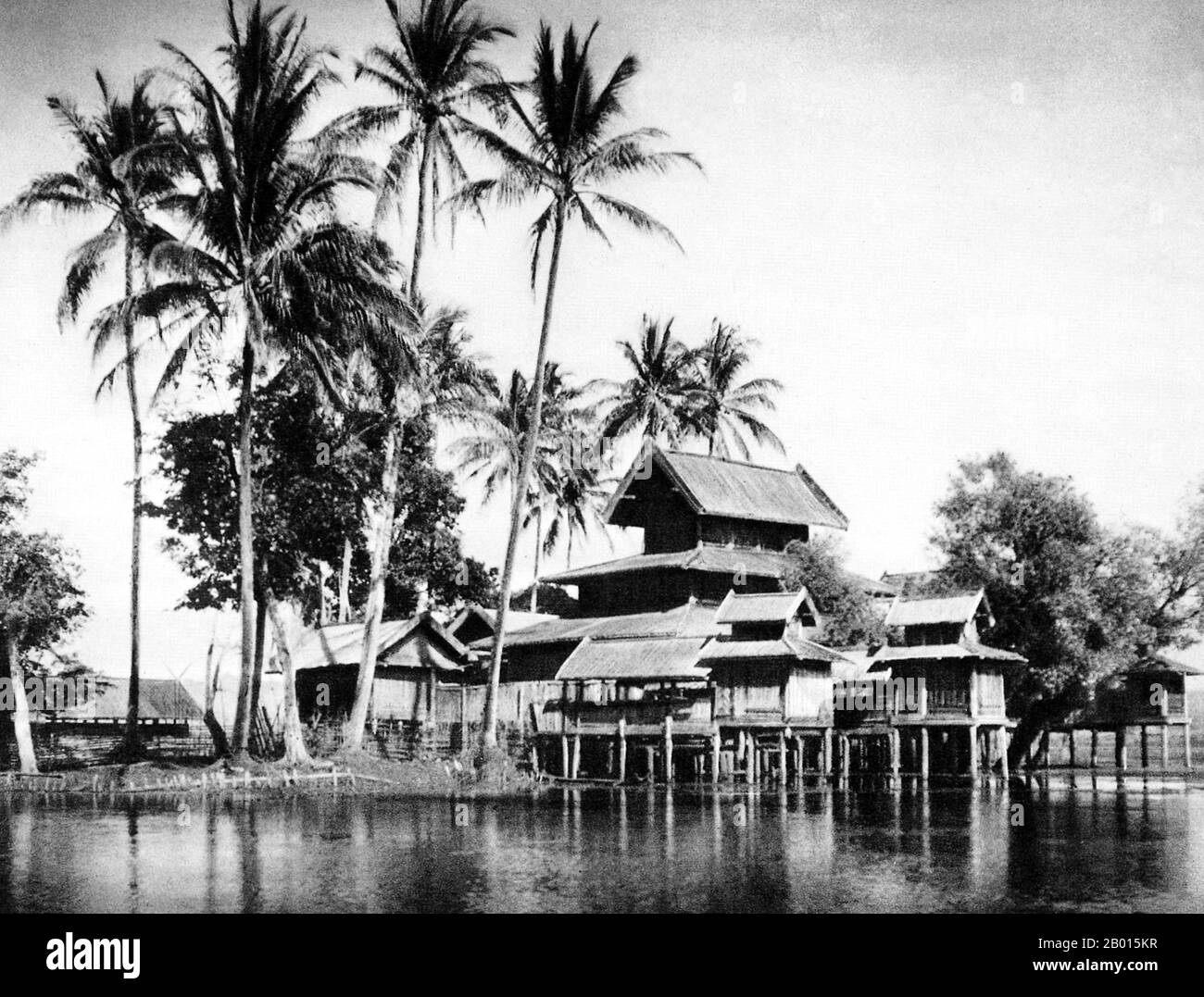 Burma/Myanmar: A Buddhist monastery overlooks the Balu River near Mong Pai in southern Shan State, c. 1920s. The British conquest of Burma began in 1824 in response to a Burmese attempt to invade India. By 1886, and after two further wars, Britain had incorporated the entire country into the British Raj. To stimulate trade and facilitate changes, the British brought in Indians and Chinese, who quickly displaced the Burmese in urban areas. To this day Rangoon and Mandalay have large ethnic Indian populations. Railways and schools were built, as well as a large number of prisons. Stock Photohttps://www.alamy.com/image-license-details/?v=1https://www.alamy.com/burmamyanmar-a-buddhist-monastery-overlooks-the-balu-river-near-mong-pai-in-southern-shan-state-c-1920s-the-british-conquest-of-burma-began-in-1824-in-response-to-a-burmese-attempt-to-invade-india-by-1886-and-after-two-further-wars-britain-had-incorporated-the-entire-country-into-the-british-raj-to-stimulate-trade-and-facilitate-changes-the-british-brought-in-indians-and-chinese-who-quickly-displaced-the-burmese-in-urban-areas-to-this-day-rangoon-and-mandalay-have-large-ethnic-indian-populations-railways-and-schools-were-built-as-well-as-a-large-number-of-prisons-image344233787.html
Burma/Myanmar: A Buddhist monastery overlooks the Balu River near Mong Pai in southern Shan State, c. 1920s. The British conquest of Burma began in 1824 in response to a Burmese attempt to invade India. By 1886, and after two further wars, Britain had incorporated the entire country into the British Raj. To stimulate trade and facilitate changes, the British brought in Indians and Chinese, who quickly displaced the Burmese in urban areas. To this day Rangoon and Mandalay have large ethnic Indian populations. Railways and schools were built, as well as a large number of prisons. Stock Photohttps://www.alamy.com/image-license-details/?v=1https://www.alamy.com/burmamyanmar-a-buddhist-monastery-overlooks-the-balu-river-near-mong-pai-in-southern-shan-state-c-1920s-the-british-conquest-of-burma-began-in-1824-in-response-to-a-burmese-attempt-to-invade-india-by-1886-and-after-two-further-wars-britain-had-incorporated-the-entire-country-into-the-british-raj-to-stimulate-trade-and-facilitate-changes-the-british-brought-in-indians-and-chinese-who-quickly-displaced-the-burmese-in-urban-areas-to-this-day-rangoon-and-mandalay-have-large-ethnic-indian-populations-railways-and-schools-were-built-as-well-as-a-large-number-of-prisons-image344233787.htmlRM2B015KR–Burma/Myanmar: A Buddhist monastery overlooks the Balu River near Mong Pai in southern Shan State, c. 1920s. The British conquest of Burma began in 1824 in response to a Burmese attempt to invade India. By 1886, and after two further wars, Britain had incorporated the entire country into the British Raj. To stimulate trade and facilitate changes, the British brought in Indians and Chinese, who quickly displaced the Burmese in urban areas. To this day Rangoon and Mandalay have large ethnic Indian populations. Railways and schools were built, as well as a large number of prisons.
 Black And White Photo Of The Entrance To The Thian Hock Keng Temple After Dark, Telok Ayer Street, Singapore. Stock Photohttps://www.alamy.com/image-license-details/?v=1https://www.alamy.com/black-and-white-photo-of-the-entrance-to-the-thian-hock-keng-temple-after-dark-telok-ayer-street-singapore-image571397402.html
Black And White Photo Of The Entrance To The Thian Hock Keng Temple After Dark, Telok Ayer Street, Singapore. Stock Photohttps://www.alamy.com/image-license-details/?v=1https://www.alamy.com/black-and-white-photo-of-the-entrance-to-the-thian-hock-keng-temple-after-dark-telok-ayer-street-singapore-image571397402.htmlRM2T5HB62–Black And White Photo Of The Entrance To The Thian Hock Keng Temple After Dark, Telok Ayer Street, Singapore.
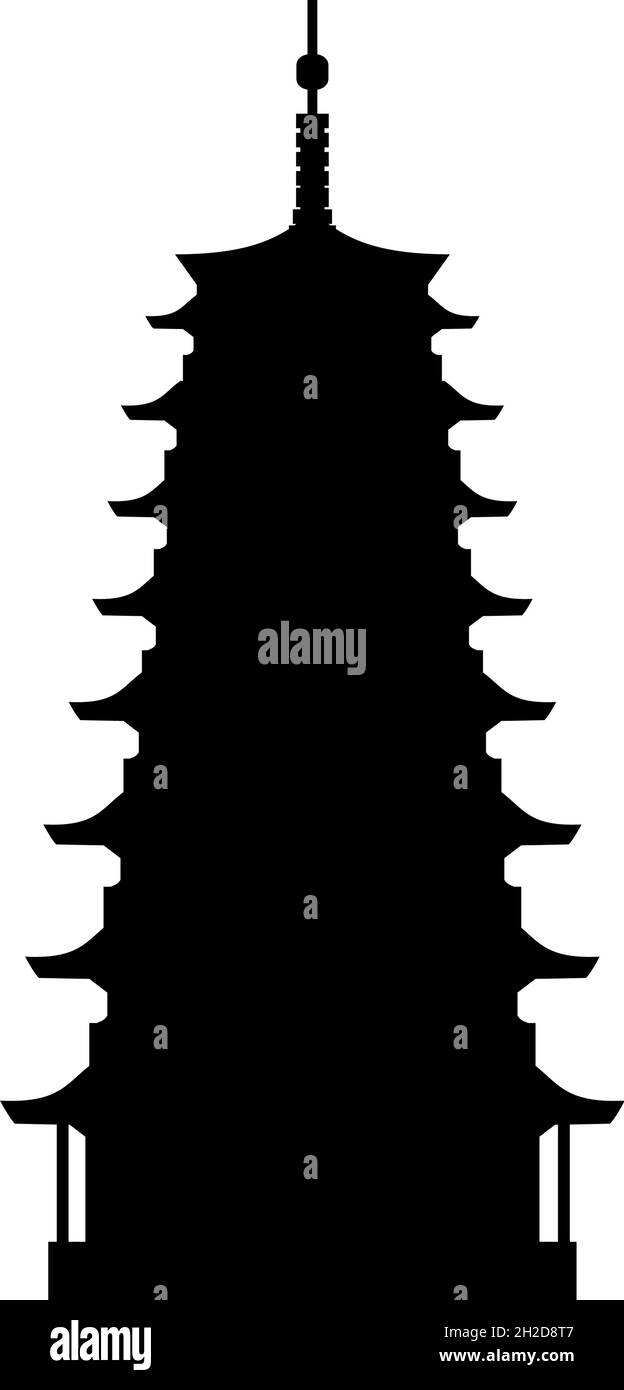 Silhouette Chinese pagoda temple. China ancient historical architecture. Stock Vectorhttps://www.alamy.com/image-license-details/?v=1https://www.alamy.com/silhouette-chinese-pagoda-temple-china-ancient-historical-architecture-image448991207.html
Silhouette Chinese pagoda temple. China ancient historical architecture. Stock Vectorhttps://www.alamy.com/image-license-details/?v=1https://www.alamy.com/silhouette-chinese-pagoda-temple-china-ancient-historical-architecture-image448991207.htmlRF2H2D8T7–Silhouette Chinese pagoda temple. China ancient historical architecture.
 PENANG, MALAYSIA, DECEMBER 19 2017: Wish ribbons in chinese buddhist Kek lok Si temple in Georgetown, Malaysia Stock Photohttps://www.alamy.com/image-license-details/?v=1https://www.alamy.com/stock-photo-penang-malaysia-december-19-2017-wish-ribbons-in-chinese-buddhist-175516787.html
PENANG, MALAYSIA, DECEMBER 19 2017: Wish ribbons in chinese buddhist Kek lok Si temple in Georgetown, Malaysia Stock Photohttps://www.alamy.com/image-license-details/?v=1https://www.alamy.com/stock-photo-penang-malaysia-december-19-2017-wish-ribbons-in-chinese-buddhist-175516787.htmlRFM5FDCK–PENANG, MALAYSIA, DECEMBER 19 2017: Wish ribbons in chinese buddhist Kek lok Si temple in Georgetown, Malaysia
 Chinese bazaar in plaza in front of a Buddhist temple, with people arriving by carriage, cart, and on foot Stock Photohttps://www.alamy.com/image-license-details/?v=1https://www.alamy.com/chinese-bazaar-in-plaza-in-front-of-a-buddhist-temple-with-people-arriving-by-carriage-cart-and-on-foot-image259745178.html
Chinese bazaar in plaza in front of a Buddhist temple, with people arriving by carriage, cart, and on foot Stock Photohttps://www.alamy.com/image-license-details/?v=1https://www.alamy.com/chinese-bazaar-in-plaza-in-front-of-a-buddhist-temple-with-people-arriving-by-carriage-cart-and-on-foot-image259745178.htmlRMW2GBHE–Chinese bazaar in plaza in front of a Buddhist temple, with people arriving by carriage, cart, and on foot
 PENANG, MALAYSIA, December 19 2017: Giant pink joss sticks burning at a vintage Buddhist temple courtyard as offering during Chinese New Year in Penan Stock Photohttps://www.alamy.com/image-license-details/?v=1https://www.alamy.com/stock-photo-penang-malaysia-december-19-2017-giant-pink-joss-sticks-burning-at-175516753.html
PENANG, MALAYSIA, December 19 2017: Giant pink joss sticks burning at a vintage Buddhist temple courtyard as offering during Chinese New Year in Penan Stock Photohttps://www.alamy.com/image-license-details/?v=1https://www.alamy.com/stock-photo-penang-malaysia-december-19-2017-giant-pink-joss-sticks-burning-at-175516753.htmlRFM5FDBD–PENANG, MALAYSIA, December 19 2017: Giant pink joss sticks burning at a vintage Buddhist temple courtyard as offering during Chinese New Year in Penan
 Wooden buildings and the celestial kings hall at baoshan buddhist temple located in the baoshan district of shanghai china. Stock Photohttps://www.alamy.com/image-license-details/?v=1https://www.alamy.com/stock-photo-wooden-buildings-and-the-celestial-kings-hall-at-baoshan-buddhist-111600140.html
Wooden buildings and the celestial kings hall at baoshan buddhist temple located in the baoshan district of shanghai china. Stock Photohttps://www.alamy.com/image-license-details/?v=1https://www.alamy.com/stock-photo-wooden-buildings-and-the-celestial-kings-hall-at-baoshan-buddhist-111600140.htmlRFGDFR38–Wooden buildings and the celestial kings hall at baoshan buddhist temple located in the baoshan district of shanghai china.
 Chinese bazaar in plaza in front of a Buddhist temple, with people arriving by carriage, cart, and on foot Stock Photohttps://www.alamy.com/image-license-details/?v=1https://www.alamy.com/chinese-bazaar-in-plaza-in-front-of-a-buddhist-temple-with-people-arriving-by-carriage-cart-and-on-foot-image264523338.html
Chinese bazaar in plaza in front of a Buddhist temple, with people arriving by carriage, cart, and on foot Stock Photohttps://www.alamy.com/image-license-details/?v=1https://www.alamy.com/chinese-bazaar-in-plaza-in-front-of-a-buddhist-temple-with-people-arriving-by-carriage-cart-and-on-foot-image264523338.htmlRMWAA262–Chinese bazaar in plaza in front of a Buddhist temple, with people arriving by carriage, cart, and on foot
 Stone statue of Budha with drape background Stock Photohttps://www.alamy.com/image-license-details/?v=1https://www.alamy.com/stock-photo-stone-statue-of-budha-with-drape-background-137955607.html
Stone statue of Budha with drape background Stock Photohttps://www.alamy.com/image-license-details/?v=1https://www.alamy.com/stock-photo-stone-statue-of-budha-with-drape-background-137955607.htmlRFJ0CBNY–Stone statue of Budha with drape background
 religion, church, temple, art, culture, stone, asia, sculpture, goal, passage, Stock Photohttps://www.alamy.com/image-license-details/?v=1https://www.alamy.com/stock-photo-religion-church-temple-art-culture-stone-asia-sculpture-goal-passage-143973450.html
religion, church, temple, art, culture, stone, asia, sculpture, goal, passage, Stock Photohttps://www.alamy.com/image-license-details/?v=1https://www.alamy.com/stock-photo-religion-church-temple-art-culture-stone-asia-sculpture-goal-passage-143973450.htmlRFJA6FGX–religion, church, temple, art, culture, stone, asia, sculpture, goal, passage,
 Chinese Buddhist Temple, between c1910 and c1915. Stock Photohttps://www.alamy.com/image-license-details/?v=1https://www.alamy.com/chinese-buddhist-temple-between-c1910-and-c1915-image608951260.html
Chinese Buddhist Temple, between c1910 and c1915. Stock Photohttps://www.alamy.com/image-license-details/?v=1https://www.alamy.com/chinese-buddhist-temple-between-c1910-and-c1915-image608951260.htmlRM2XAM3F8–Chinese Buddhist Temple, between c1910 and c1915.
 Beijing temple prayer wheel Stock Photohttps://www.alamy.com/image-license-details/?v=1https://www.alamy.com/beijing-temple-prayer-wheel-image344624268.html
Beijing temple prayer wheel Stock Photohttps://www.alamy.com/image-license-details/?v=1https://www.alamy.com/beijing-temple-prayer-wheel-image344624268.htmlRM2B0JYNG–Beijing temple prayer wheel
![Sketches in China - the Consecration of a Buddhist Abbot at the Temple of Honam - drawn by our special artist and correspondent, 1858. 'The Abbot in scarlet and purple, [is] kneeling and presenting offerings to the gods, whilst the four priests are handing to him the dishes in which the offerings are placed. On each side are the monks, who every now and then go down and knock their foreheads on the ground, chanting the whole time. The altar has three wooden idols, painted to represent priests in red robes, whilst wax tapers are burning as in Roman Catholic churches...The Abbot wore a kind of r Stock Photo Sketches in China - the Consecration of a Buddhist Abbot at the Temple of Honam - drawn by our special artist and correspondent, 1858. 'The Abbot in scarlet and purple, [is] kneeling and presenting offerings to the gods, whilst the four priests are handing to him the dishes in which the offerings are placed. On each side are the monks, who every now and then go down and knock their foreheads on the ground, chanting the whole time. The altar has three wooden idols, painted to represent priests in red robes, whilst wax tapers are burning as in Roman Catholic churches...The Abbot wore a kind of r Stock Photo](https://c8.alamy.com/comp/2RRJ84X/sketches-in-china-the-consecration-of-a-buddhist-abbot-at-the-temple-of-honam-drawn-by-our-special-artist-and-correspondent-1858-the-abbot-in-scarlet-and-purple-is-kneeling-and-presenting-offerings-to-the-gods-whilst-the-four-priests-are-handing-to-him-the-dishes-in-which-the-offerings-are-placed-on-each-side-are-the-monks-who-every-now-and-then-go-down-and-knock-their-foreheads-on-the-ground-chanting-the-whole-time-the-altar-has-three-wooden-idols-painted-to-represent-priests-in-red-robes-whilst-wax-tapers-are-burning-as-in-roman-catholic-churchesthe-abbot-wore-a-kind-of-r-2RRJ84X.jpg) Sketches in China - the Consecration of a Buddhist Abbot at the Temple of Honam - drawn by our special artist and correspondent, 1858. 'The Abbot in scarlet and purple, [is] kneeling and presenting offerings to the gods, whilst the four priests are handing to him the dishes in which the offerings are placed. On each side are the monks, who every now and then go down and knock their foreheads on the ground, chanting the whole time. The altar has three wooden idols, painted to represent priests in red robes, whilst wax tapers are burning as in Roman Catholic churches...The Abbot wore a kind of r Stock Photohttps://www.alamy.com/image-license-details/?v=1https://www.alamy.com/sketches-in-china-the-consecration-of-a-buddhist-abbot-at-the-temple-of-honam-drawn-by-our-special-artist-and-correspondent-1858-the-abbot-in-scarlet-and-purple-is-kneeling-and-presenting-offerings-to-the-gods-whilst-the-four-priests-are-handing-to-him-the-dishes-in-which-the-offerings-are-placed-on-each-side-are-the-monks-who-every-now-and-then-go-down-and-knock-their-foreheads-on-the-ground-chanting-the-whole-time-the-altar-has-three-wooden-idols-painted-to-represent-priests-in-red-robes-whilst-wax-tapers-are-burning-as-in-roman-catholic-churchesthe-abbot-wore-a-kind-of-r-image565270410.html
Sketches in China - the Consecration of a Buddhist Abbot at the Temple of Honam - drawn by our special artist and correspondent, 1858. 'The Abbot in scarlet and purple, [is] kneeling and presenting offerings to the gods, whilst the four priests are handing to him the dishes in which the offerings are placed. On each side are the monks, who every now and then go down and knock their foreheads on the ground, chanting the whole time. The altar has three wooden idols, painted to represent priests in red robes, whilst wax tapers are burning as in Roman Catholic churches...The Abbot wore a kind of r Stock Photohttps://www.alamy.com/image-license-details/?v=1https://www.alamy.com/sketches-in-china-the-consecration-of-a-buddhist-abbot-at-the-temple-of-honam-drawn-by-our-special-artist-and-correspondent-1858-the-abbot-in-scarlet-and-purple-is-kneeling-and-presenting-offerings-to-the-gods-whilst-the-four-priests-are-handing-to-him-the-dishes-in-which-the-offerings-are-placed-on-each-side-are-the-monks-who-every-now-and-then-go-down-and-knock-their-foreheads-on-the-ground-chanting-the-whole-time-the-altar-has-three-wooden-idols-painted-to-represent-priests-in-red-robes-whilst-wax-tapers-are-burning-as-in-roman-catholic-churchesthe-abbot-wore-a-kind-of-r-image565270410.htmlRM2RRJ84X–Sketches in China - the Consecration of a Buddhist Abbot at the Temple of Honam - drawn by our special artist and correspondent, 1858. 'The Abbot in scarlet and purple, [is] kneeling and presenting offerings to the gods, whilst the four priests are handing to him the dishes in which the offerings are placed. On each side are the monks, who every now and then go down and knock their foreheads on the ground, chanting the whole time. The altar has three wooden idols, painted to represent priests in red robes, whilst wax tapers are burning as in Roman Catholic churches...The Abbot wore a kind of r
 Amazing Sculptured Buddha in a zen garden Stock Photohttps://www.alamy.com/image-license-details/?v=1https://www.alamy.com/stock-photo-amazing-sculptured-buddha-in-a-zen-garden-145996293.html
Amazing Sculptured Buddha in a zen garden Stock Photohttps://www.alamy.com/image-license-details/?v=1https://www.alamy.com/stock-photo-amazing-sculptured-buddha-in-a-zen-garden-145996293.htmlRFJDEKN9–Amazing Sculptured Buddha in a zen garden
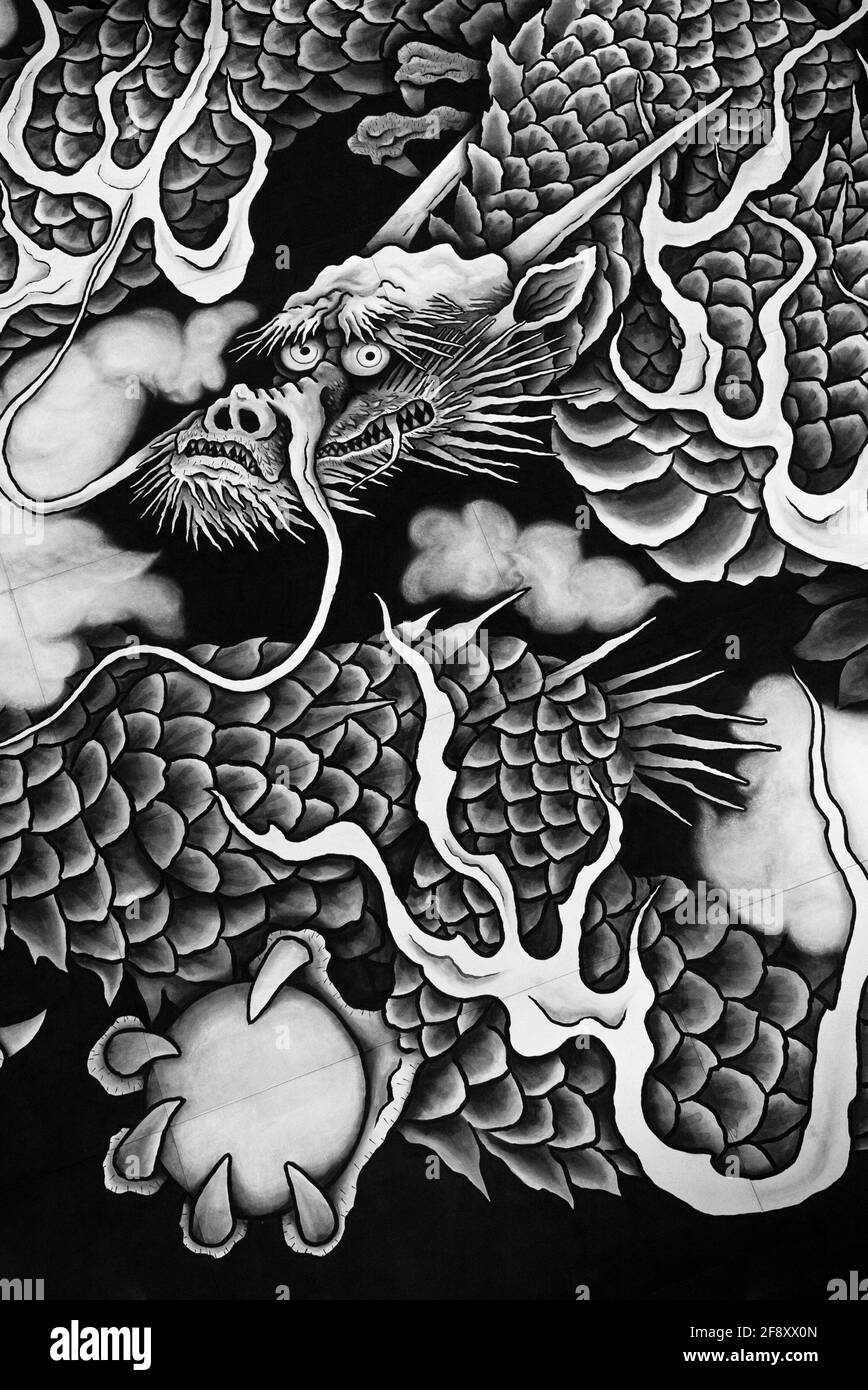 Dragon painting at Kencho-ji Zen Buddhist Temple. Kenchoji. Junsaku Koizumi. Unryu, Dragon amid clouds. Kamakura, Japan. Dragon ball background. Stock Photohttps://www.alamy.com/image-license-details/?v=1https://www.alamy.com/dragon-painting-at-kencho-ji-zen-buddhist-temple-kenchoji-junsaku-koizumi-unryu-dragon-amid-clouds-kamakura-japan-dragon-ball-background-image418557237.html
Dragon painting at Kencho-ji Zen Buddhist Temple. Kenchoji. Junsaku Koizumi. Unryu, Dragon amid clouds. Kamakura, Japan. Dragon ball background. Stock Photohttps://www.alamy.com/image-license-details/?v=1https://www.alamy.com/dragon-painting-at-kencho-ji-zen-buddhist-temple-kenchoji-junsaku-koizumi-unryu-dragon-amid-clouds-kamakura-japan-dragon-ball-background-image418557237.htmlRF2F8XX0N–Dragon painting at Kencho-ji Zen Buddhist Temple. Kenchoji. Junsaku Koizumi. Unryu, Dragon amid clouds. Kamakura, Japan. Dragon ball background.
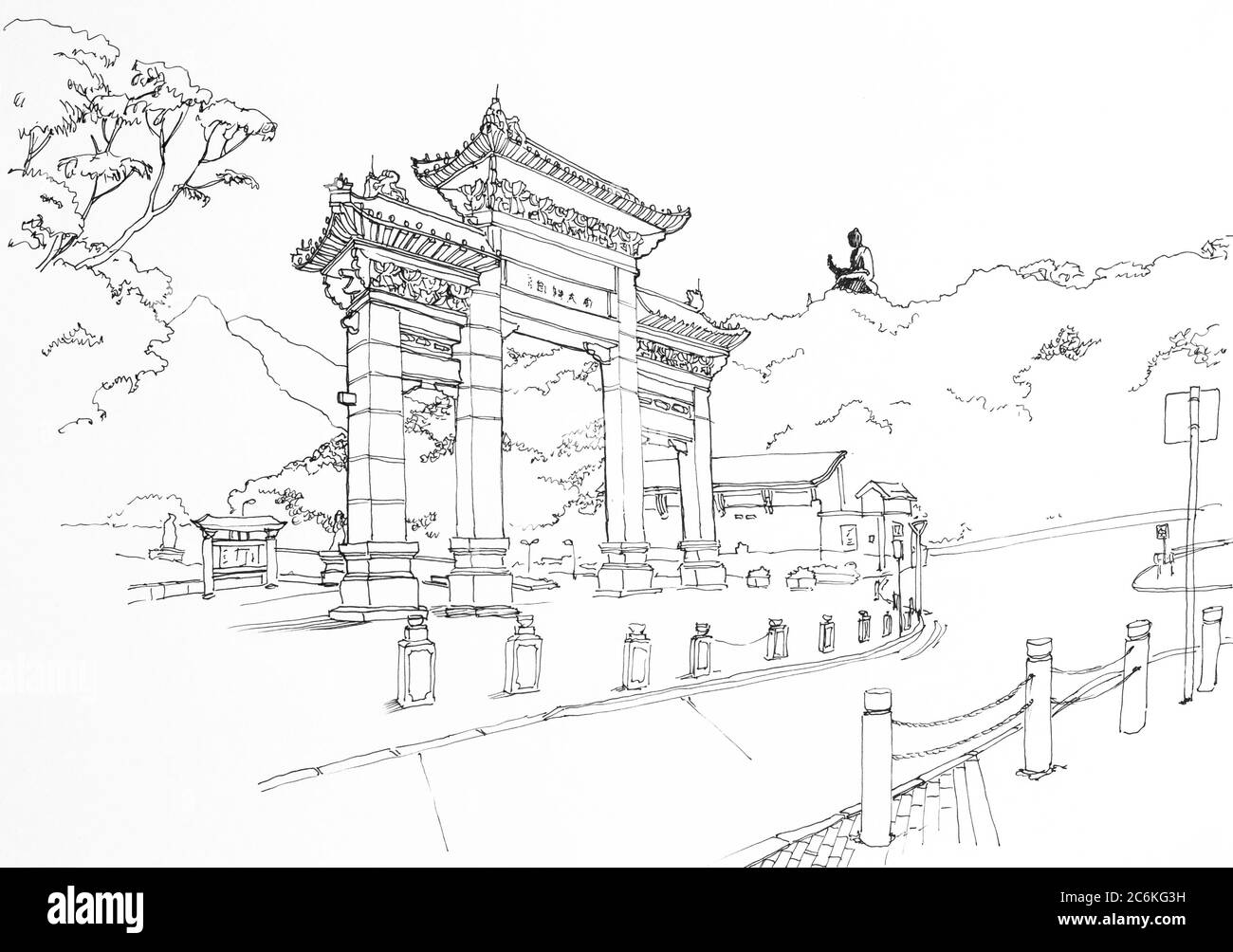 Hand drawn sketch of Entrance Gate to the Po Lin Monastery, Lantau Island, Hong Kong, China Stock Photohttps://www.alamy.com/image-license-details/?v=1https://www.alamy.com/hand-drawn-sketch-of-entrance-gate-to-the-po-lin-monastery-lantau-island-hong-kong-china-image365535397.html
Hand drawn sketch of Entrance Gate to the Po Lin Monastery, Lantau Island, Hong Kong, China Stock Photohttps://www.alamy.com/image-license-details/?v=1https://www.alamy.com/hand-drawn-sketch-of-entrance-gate-to-the-po-lin-monastery-lantau-island-hong-kong-china-image365535397.htmlRF2C6KG3H–Hand drawn sketch of Entrance Gate to the Po Lin Monastery, Lantau Island, Hong Kong, China
 Temples gong . Stock Vectorhttps://www.alamy.com/image-license-details/?v=1https://www.alamy.com/temples-gong-image475434212.html
Temples gong . Stock Vectorhttps://www.alamy.com/image-license-details/?v=1https://www.alamy.com/temples-gong-image475434212.htmlRF2JHDW58–Temples gong .
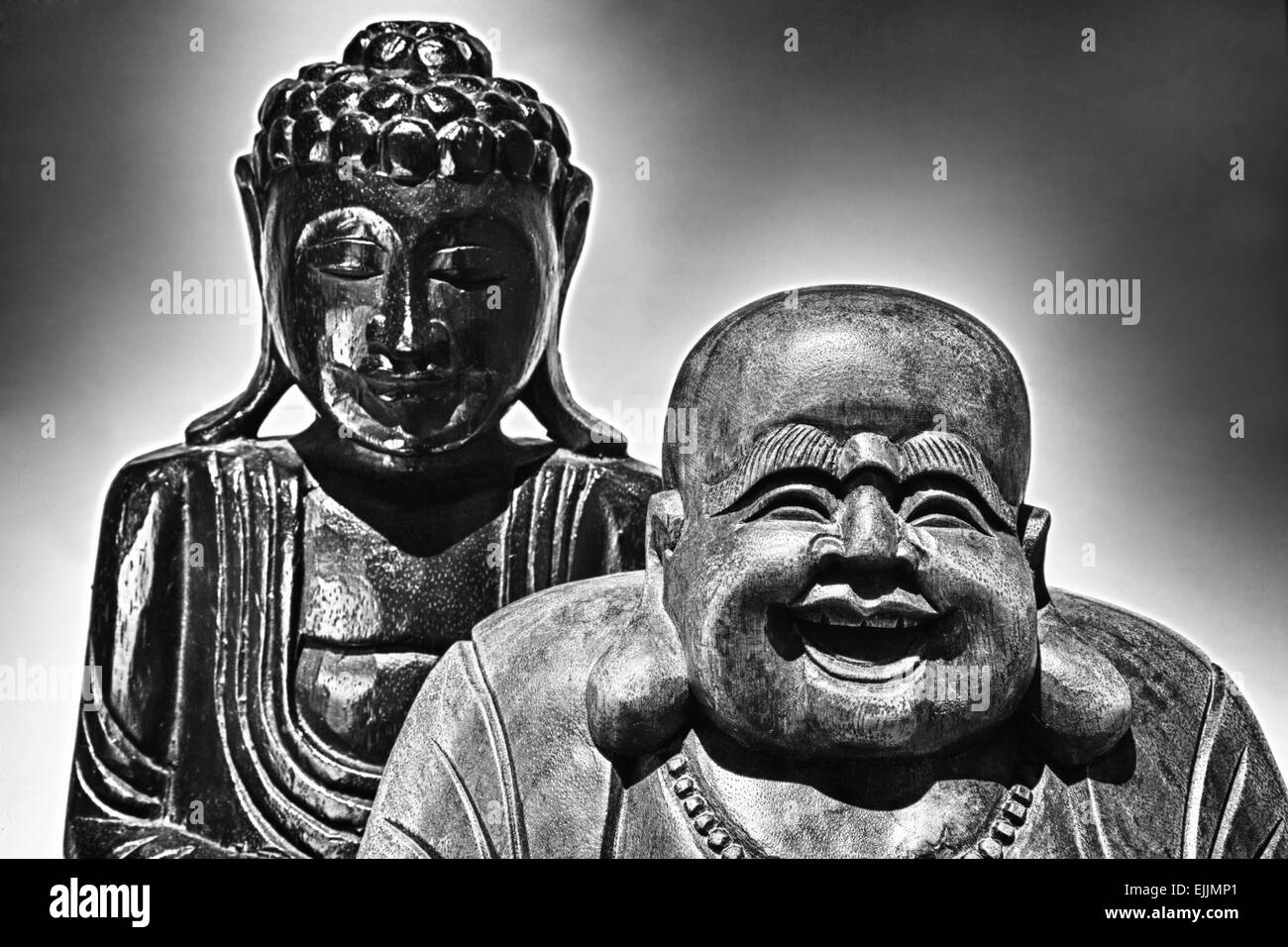 Chinese and thailand representation on wooden figurines of Buddha Stock Photohttps://www.alamy.com/image-license-details/?v=1https://www.alamy.com/stock-photo-chinese-and-thailand-representation-on-wooden-figurines-of-buddha-80316713.html
Chinese and thailand representation on wooden figurines of Buddha Stock Photohttps://www.alamy.com/image-license-details/?v=1https://www.alamy.com/stock-photo-chinese-and-thailand-representation-on-wooden-figurines-of-buddha-80316713.htmlRFEJJMP1–Chinese and thailand representation on wooden figurines of Buddha
 Temple of Dawn, Bangkok, Thailand, black and white Stock Photohttps://www.alamy.com/image-license-details/?v=1https://www.alamy.com/stock-photo-temple-of-dawn-bangkok-thailand-black-and-white-43353528.html
Temple of Dawn, Bangkok, Thailand, black and white Stock Photohttps://www.alamy.com/image-license-details/?v=1https://www.alamy.com/stock-photo-temple-of-dawn-bangkok-thailand-black-and-white-43353528.htmlRFCEEWT8–Temple of Dawn, Bangkok, Thailand, black and white
 Buddhist monk pattern, simple style Stock Vectorhttps://www.alamy.com/image-license-details/?v=1https://www.alamy.com/buddhist-monk-pattern-simple-style-image444133857.html
Buddhist monk pattern, simple style Stock Vectorhttps://www.alamy.com/image-license-details/?v=1https://www.alamy.com/buddhist-monk-pattern-simple-style-image444133857.htmlRF2GPG17D–Buddhist monk pattern, simple style
 White Pagoda Dagoba Bai Ta Jade Island Beihai Park Beijing Peking China Chinese Asian Asiatic Asia Stock Photohttps://www.alamy.com/image-license-details/?v=1https://www.alamy.com/white-pagoda-dagoba-bai-ta-jade-island-beihai-park-beijing-peking-image2144396.html
White Pagoda Dagoba Bai Ta Jade Island Beihai Park Beijing Peking China Chinese Asian Asiatic Asia Stock Photohttps://www.alamy.com/image-license-details/?v=1https://www.alamy.com/white-pagoda-dagoba-bai-ta-jade-island-beihai-park-beijing-peking-image2144396.htmlRMA6K88D–White Pagoda Dagoba Bai Ta Jade Island Beihai Park Beijing Peking China Chinese Asian Asiatic Asia
 Temple of the Gods, Canton, China, Antique Chinese Photograph, 1893 Stock Photohttps://www.alamy.com/image-license-details/?v=1https://www.alamy.com/temple-of-the-gods-canton-china-antique-chinese-photograph-1893-image233504123.html
Temple of the Gods, Canton, China, Antique Chinese Photograph, 1893 Stock Photohttps://www.alamy.com/image-license-details/?v=1https://www.alamy.com/temple-of-the-gods-canton-china-antique-chinese-photograph-1893-image233504123.htmlRMRFW0TY–Temple of the Gods, Canton, China, Antique Chinese Photograph, 1893
RF2Y7YXE5–China pagoda temple tower shape Chinese oriental architecture building structure tourist destination religious place design icon
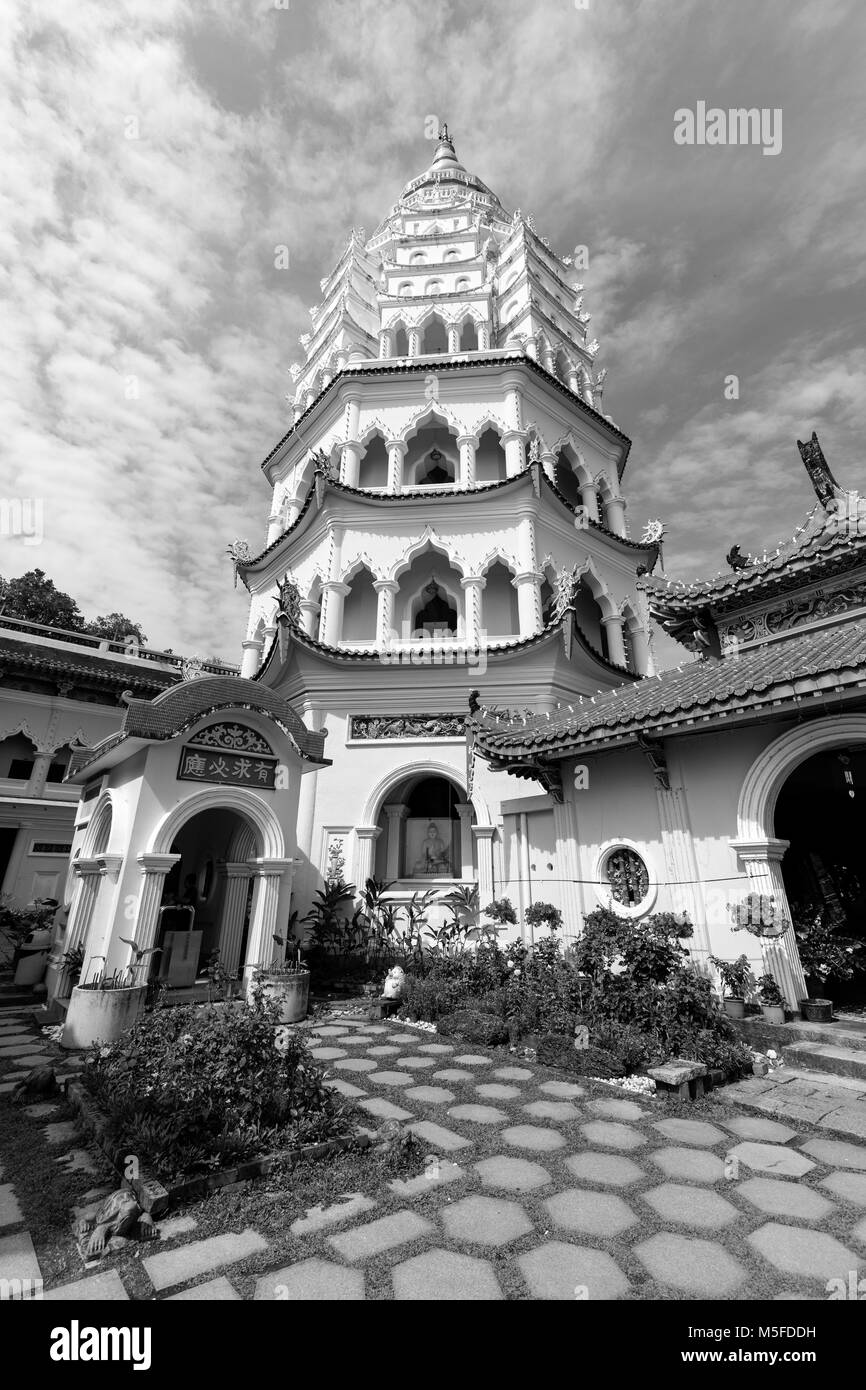 Buddhist temple Kek Lok Si with Pagoda in Penang, Malaysia, Georgetown Stock Photohttps://www.alamy.com/image-license-details/?v=1https://www.alamy.com/stock-photo-buddhist-temple-kek-lok-si-with-pagoda-in-penang-malaysia-georgetown-175516813.html
Buddhist temple Kek Lok Si with Pagoda in Penang, Malaysia, Georgetown Stock Photohttps://www.alamy.com/image-license-details/?v=1https://www.alamy.com/stock-photo-buddhist-temple-kek-lok-si-with-pagoda-in-penang-malaysia-georgetown-175516813.htmlRFM5FDDH–Buddhist temple Kek Lok Si with Pagoda in Penang, Malaysia, Georgetown
 Kuala Lumpur, Malaysia - December 2, 2019: View of the Thean Hou Chinese temple in Kuala Lumpur, Malaysia. Black and white photo in retro style. Stock Photohttps://www.alamy.com/image-license-details/?v=1https://www.alamy.com/kuala-lumpur-malaysia-december-2-2019-view-of-the-thean-hou-chinese-temple-in-kuala-lumpur-malaysia-black-and-white-photo-in-retro-style-image381264754.html
Kuala Lumpur, Malaysia - December 2, 2019: View of the Thean Hou Chinese temple in Kuala Lumpur, Malaysia. Black and white photo in retro style. Stock Photohttps://www.alamy.com/image-license-details/?v=1https://www.alamy.com/kuala-lumpur-malaysia-december-2-2019-view-of-the-thean-hou-chinese-temple-in-kuala-lumpur-malaysia-black-and-white-photo-in-retro-style-image381264754.htmlRF2D4832A–Kuala Lumpur, Malaysia - December 2, 2019: View of the Thean Hou Chinese temple in Kuala Lumpur, Malaysia. Black and white photo in retro style.
 Worshippers at Lama Temple Stock Photohttps://www.alamy.com/image-license-details/?v=1https://www.alamy.com/stock-photo-worshippers-at-lama-temple-97478242.html
Worshippers at Lama Temple Stock Photohttps://www.alamy.com/image-license-details/?v=1https://www.alamy.com/stock-photo-worshippers-at-lama-temple-97478242.htmlRMFJGEDP–Worshippers at Lama Temple
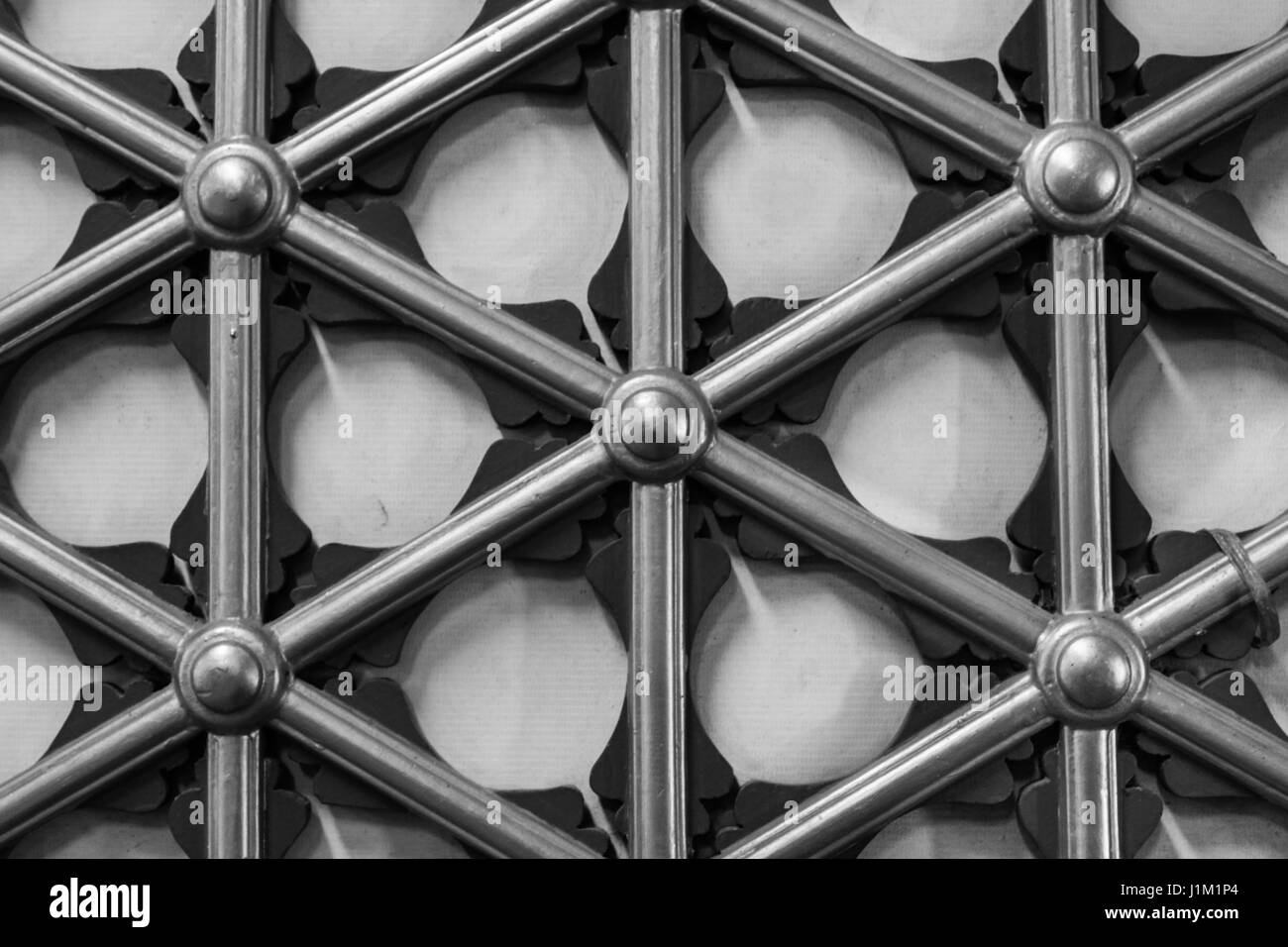 Beautiful Chinese interior pattern monochrome Stock Photohttps://www.alamy.com/image-license-details/?v=1https://www.alamy.com/stock-photo-beautiful-chinese-interior-pattern-monochrome-138738044.html
Beautiful Chinese interior pattern monochrome Stock Photohttps://www.alamy.com/image-license-details/?v=1https://www.alamy.com/stock-photo-beautiful-chinese-interior-pattern-monochrome-138738044.htmlRFJ1M1P4–Beautiful Chinese interior pattern monochrome
 Stone statue of Budha with drape background Stock Photohttps://www.alamy.com/image-license-details/?v=1https://www.alamy.com/stock-photo-stone-statue-of-budha-with-drape-background-137955603.html
Stone statue of Budha with drape background Stock Photohttps://www.alamy.com/image-license-details/?v=1https://www.alamy.com/stock-photo-stone-statue-of-budha-with-drape-background-137955603.htmlRFJ0CBNR–Stone statue of Budha with drape background
 The 10000 Buddhas Temple in Hong Kong Stock Photohttps://www.alamy.com/image-license-details/?v=1https://www.alamy.com/the-10000-buddhas-temple-in-hong-kong-image255478351.html
The 10000 Buddhas Temple in Hong Kong Stock Photohttps://www.alamy.com/image-license-details/?v=1https://www.alamy.com/the-10000-buddhas-temple-in-hong-kong-image255478351.htmlRFTRJ16R–The 10000 Buddhas Temple in Hong Kong
 Burma/Myanmar: The main street of Bhamo, Kachin State, c. 1893. Bhamo (known to the Chinese as Xinkai, or 'New Market'), was once an important town on the Haw caravan trade route between China and Burma. Within the Shan and Karen inhabited regions of northern and eastern Burma trade routes ran to Myitkyina, Lashio and Bhamo. Large mule caravans, some 'half a mile long' were still arriving in Bhamo as late as the 1920s. Stock Photohttps://www.alamy.com/image-license-details/?v=1https://www.alamy.com/burmamyanmar-the-main-street-of-bhamo-kachin-state-c-1893-bhamo-known-to-the-chinese-as-xinkai-or-new-market-was-once-an-important-town-on-the-haw-caravan-trade-route-between-china-and-burma-within-the-shan-and-karen-inhabited-regions-of-northern-and-eastern-burma-trade-routes-ran-to-myitkyina-lashio-and-bhamo-large-mule-caravans-some-half-a-mile-long-were-still-arriving-in-bhamo-as-late-as-the-1920s-image344252994.html
Burma/Myanmar: The main street of Bhamo, Kachin State, c. 1893. Bhamo (known to the Chinese as Xinkai, or 'New Market'), was once an important town on the Haw caravan trade route between China and Burma. Within the Shan and Karen inhabited regions of northern and eastern Burma trade routes ran to Myitkyina, Lashio and Bhamo. Large mule caravans, some 'half a mile long' were still arriving in Bhamo as late as the 1920s. Stock Photohttps://www.alamy.com/image-license-details/?v=1https://www.alamy.com/burmamyanmar-the-main-street-of-bhamo-kachin-state-c-1893-bhamo-known-to-the-chinese-as-xinkai-or-new-market-was-once-an-important-town-on-the-haw-caravan-trade-route-between-china-and-burma-within-the-shan-and-karen-inhabited-regions-of-northern-and-eastern-burma-trade-routes-ran-to-myitkyina-lashio-and-bhamo-large-mule-caravans-some-half-a-mile-long-were-still-arriving-in-bhamo-as-late-as-the-1920s-image344252994.htmlRM2B0225P–Burma/Myanmar: The main street of Bhamo, Kachin State, c. 1893. Bhamo (known to the Chinese as Xinkai, or 'New Market'), was once an important town on the Haw caravan trade route between China and Burma. Within the Shan and Karen inhabited regions of northern and eastern Burma trade routes ran to Myitkyina, Lashio and Bhamo. Large mule caravans, some 'half a mile long' were still arriving in Bhamo as late as the 1920s.
 An old Chinese couple watches the Shaolin monks perform in Henan China Stock Photohttps://www.alamy.com/image-license-details/?v=1https://www.alamy.com/stock-photo-an-old-chinese-couple-watches-the-shaolin-monks-perform-in-henan-china-16333189.html
An old Chinese couple watches the Shaolin monks perform in Henan China Stock Photohttps://www.alamy.com/image-license-details/?v=1https://www.alamy.com/stock-photo-an-old-chinese-couple-watches-the-shaolin-monks-perform-in-henan-china-16333189.htmlRMATJN9X–An old Chinese couple watches the Shaolin monks perform in Henan China
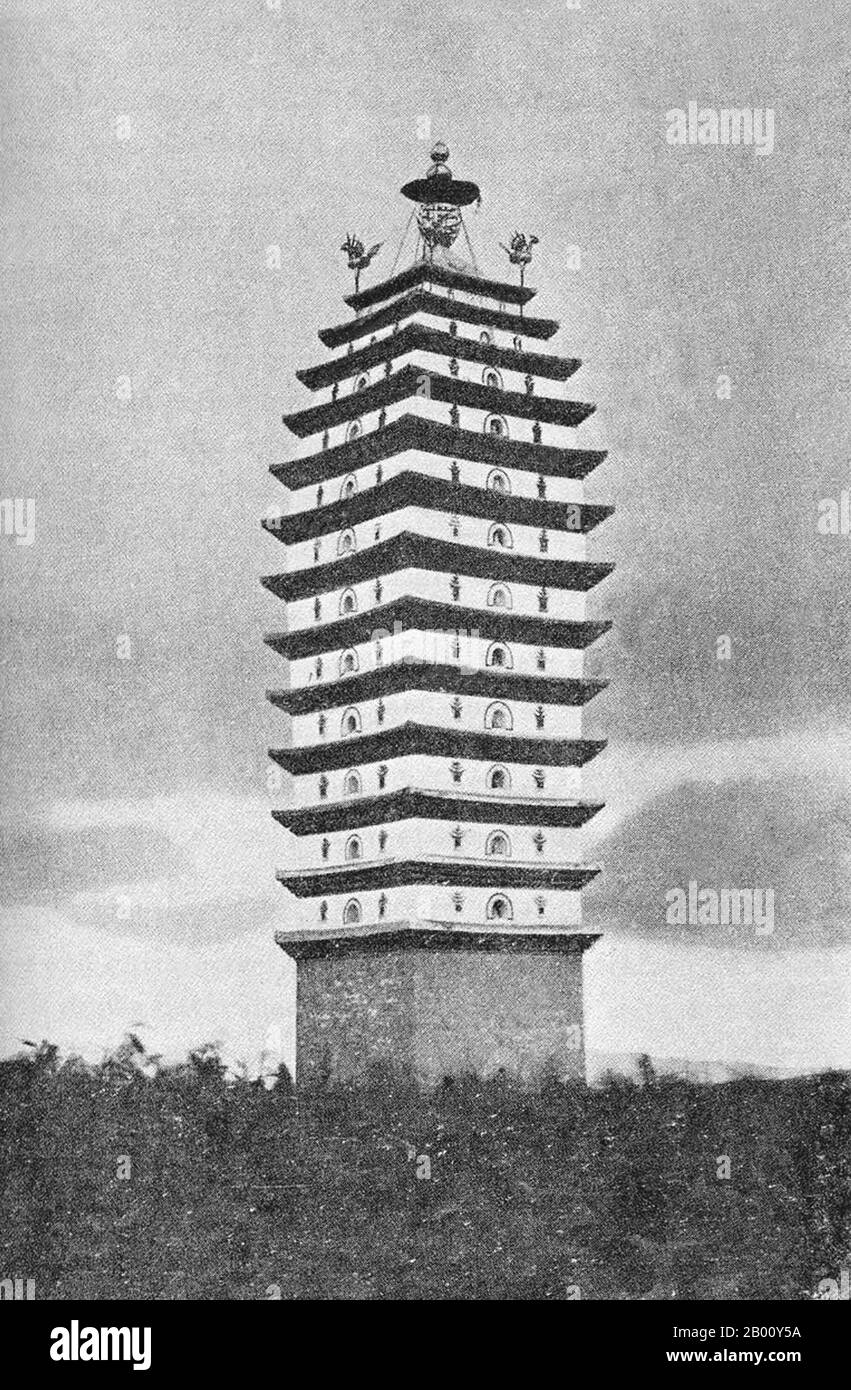 China: A Pagoda in Kunming, Yunnan. Photo by George Ernest Morrison (1862-1920), c. 1896. Built on the banks of Lake Dian and surrounded by limestone mountains, Kunming was an important ancient trade route between Tibet, China and Southeast Asia. The city, then called Yunnanfu, suffered at the hands of rebel leader Du Wenxiu, the Sultan of Dali, who attacked and besieged the city several times between 1858 and 1868, razing most of the city's Buddhist temples. Stock Photohttps://www.alamy.com/image-license-details/?v=1https://www.alamy.com/china-a-pagoda-in-kunming-yunnan-photo-by-george-ernest-morrison-1862-1920-c-1896-built-on-the-banks-of-lake-dian-and-surrounded-by-limestone-mountains-kunming-was-an-important-ancient-trade-route-between-tibet-china-and-southeast-asia-the-city-then-called-yunnanfu-suffered-at-the-hands-of-rebel-leader-du-wenxiu-the-sultan-of-dali-who-attacked-and-besieged-the-city-several-times-between-1858-and-1868-razing-most-of-the-citys-buddhist-temples-image344228678.html
China: A Pagoda in Kunming, Yunnan. Photo by George Ernest Morrison (1862-1920), c. 1896. Built on the banks of Lake Dian and surrounded by limestone mountains, Kunming was an important ancient trade route between Tibet, China and Southeast Asia. The city, then called Yunnanfu, suffered at the hands of rebel leader Du Wenxiu, the Sultan of Dali, who attacked and besieged the city several times between 1858 and 1868, razing most of the city's Buddhist temples. Stock Photohttps://www.alamy.com/image-license-details/?v=1https://www.alamy.com/china-a-pagoda-in-kunming-yunnan-photo-by-george-ernest-morrison-1862-1920-c-1896-built-on-the-banks-of-lake-dian-and-surrounded-by-limestone-mountains-kunming-was-an-important-ancient-trade-route-between-tibet-china-and-southeast-asia-the-city-then-called-yunnanfu-suffered-at-the-hands-of-rebel-leader-du-wenxiu-the-sultan-of-dali-who-attacked-and-besieged-the-city-several-times-between-1858-and-1868-razing-most-of-the-citys-buddhist-temples-image344228678.htmlRM2B00Y5A–China: A Pagoda in Kunming, Yunnan. Photo by George Ernest Morrison (1862-1920), c. 1896. Built on the banks of Lake Dian and surrounded by limestone mountains, Kunming was an important ancient trade route between Tibet, China and Southeast Asia. The city, then called Yunnanfu, suffered at the hands of rebel leader Du Wenxiu, the Sultan of Dali, who attacked and besieged the city several times between 1858 and 1868, razing most of the city's Buddhist temples.
 Amazing Sculptured Buddha surrounded by flowers Stock Photohttps://www.alamy.com/image-license-details/?v=1https://www.alamy.com/stock-photo-amazing-sculptured-buddha-surrounded-by-flowers-145996285.html
Amazing Sculptured Buddha surrounded by flowers Stock Photohttps://www.alamy.com/image-license-details/?v=1https://www.alamy.com/stock-photo-amazing-sculptured-buddha-surrounded-by-flowers-145996285.htmlRFJDEKN1–Amazing Sculptured Buddha surrounded by flowers
 The Black Flag Army (Chinese: Heiqi Jun) was a remnant of a bandit group that may have been former Taiping rebels that crossed the border from Guangxi province in China into Upper Tonkin, in the Empire of Annam (Vietnam) in 1865. They became known mainly for their fights against French forces in cooperation with both Vietnamese and Chinese authorities. The Black Flag Army is so named because of the preference of its commander, Liu Yongfu, for using black command flags. Pha That Luang, the 'Great Sacred Stupa' of Vientiane, is the most important religious edifice in Laos. It also has great sp Stock Photohttps://www.alamy.com/image-license-details/?v=1https://www.alamy.com/the-black-flag-army-chinese-heiqi-jun-was-a-remnant-of-a-bandit-group-that-may-have-been-former-taiping-rebels-that-crossed-the-border-from-guangxi-province-in-china-into-upper-tonkin-in-the-empire-of-annam-vietnam-in-1865-they-became-known-mainly-for-their-fights-against-french-forces-in-cooperation-with-both-vietnamese-and-chinese-authorities-the-black-flag-army-is-so-named-because-of-the-preference-of-its-commander-liu-yongfu-for-using-black-command-flags-pha-that-luang-the-great-sacred-stupa-of-vientiane-is-the-most-important-religious-edifice-in-laos-it-also-has-great-sp-image344255789.html
The Black Flag Army (Chinese: Heiqi Jun) was a remnant of a bandit group that may have been former Taiping rebels that crossed the border from Guangxi province in China into Upper Tonkin, in the Empire of Annam (Vietnam) in 1865. They became known mainly for their fights against French forces in cooperation with both Vietnamese and Chinese authorities. The Black Flag Army is so named because of the preference of its commander, Liu Yongfu, for using black command flags. Pha That Luang, the 'Great Sacred Stupa' of Vientiane, is the most important religious edifice in Laos. It also has great sp Stock Photohttps://www.alamy.com/image-license-details/?v=1https://www.alamy.com/the-black-flag-army-chinese-heiqi-jun-was-a-remnant-of-a-bandit-group-that-may-have-been-former-taiping-rebels-that-crossed-the-border-from-guangxi-province-in-china-into-upper-tonkin-in-the-empire-of-annam-vietnam-in-1865-they-became-known-mainly-for-their-fights-against-french-forces-in-cooperation-with-both-vietnamese-and-chinese-authorities-the-black-flag-army-is-so-named-because-of-the-preference-of-its-commander-liu-yongfu-for-using-black-command-flags-pha-that-luang-the-great-sacred-stupa-of-vientiane-is-the-most-important-religious-edifice-in-laos-it-also-has-great-sp-image344255789.htmlRM2B025NH–The Black Flag Army (Chinese: Heiqi Jun) was a remnant of a bandit group that may have been former Taiping rebels that crossed the border from Guangxi province in China into Upper Tonkin, in the Empire of Annam (Vietnam) in 1865. They became known mainly for their fights against French forces in cooperation with both Vietnamese and Chinese authorities. The Black Flag Army is so named because of the preference of its commander, Liu Yongfu, for using black command flags. Pha That Luang, the 'Great Sacred Stupa' of Vientiane, is the most important religious edifice in Laos. It also has great sp
 Standing Lion. Culture: China. Dimensions: H. 9 3/4 in. (24.8 cm). Date: 8th century. This regal lion, who steps on lotus blossoms atop an altar table, may have served as the mount for a figure of the bodhisattva Manjushri, the Buddhist embodiment of transcendent wisdom. Museum: Metropolitan Museum of Art, New York, USA. Stock Photohttps://www.alamy.com/image-license-details/?v=1https://www.alamy.com/standing-lion-culture-china-dimensions-h-9-34-in-248-cm-date-8th-century-this-regal-lion-who-steps-on-lotus-blossoms-atop-an-altar-table-may-have-served-as-the-mount-for-a-figure-of-the-bodhisattva-manjushri-the-buddhist-embodiment-of-transcendent-wisdom-museum-metropolitan-museum-of-art-new-york-usa-image212936982.html
Standing Lion. Culture: China. Dimensions: H. 9 3/4 in. (24.8 cm). Date: 8th century. This regal lion, who steps on lotus blossoms atop an altar table, may have served as the mount for a figure of the bodhisattva Manjushri, the Buddhist embodiment of transcendent wisdom. Museum: Metropolitan Museum of Art, New York, USA. Stock Photohttps://www.alamy.com/image-license-details/?v=1https://www.alamy.com/standing-lion-culture-china-dimensions-h-9-34-in-248-cm-date-8th-century-this-regal-lion-who-steps-on-lotus-blossoms-atop-an-altar-table-may-have-served-as-the-mount-for-a-figure-of-the-bodhisattva-manjushri-the-buddhist-embodiment-of-transcendent-wisdom-museum-metropolitan-museum-of-art-new-york-usa-image212936982.htmlRMPAC386–Standing Lion. Culture: China. Dimensions: H. 9 3/4 in. (24.8 cm). Date: 8th century. This regal lion, who steps on lotus blossoms atop an altar table, may have served as the mount for a figure of the bodhisattva Manjushri, the Buddhist embodiment of transcendent wisdom. Museum: Metropolitan Museum of Art, New York, USA.
 Guiyang, China Stock Photohttps://www.alamy.com/image-license-details/?v=1https://www.alamy.com/stock-photo-guiyang-china-57534734.html
Guiyang, China Stock Photohttps://www.alamy.com/image-license-details/?v=1https://www.alamy.com/stock-photo-guiyang-china-57534734.htmlRMD9GX3X–Guiyang, China
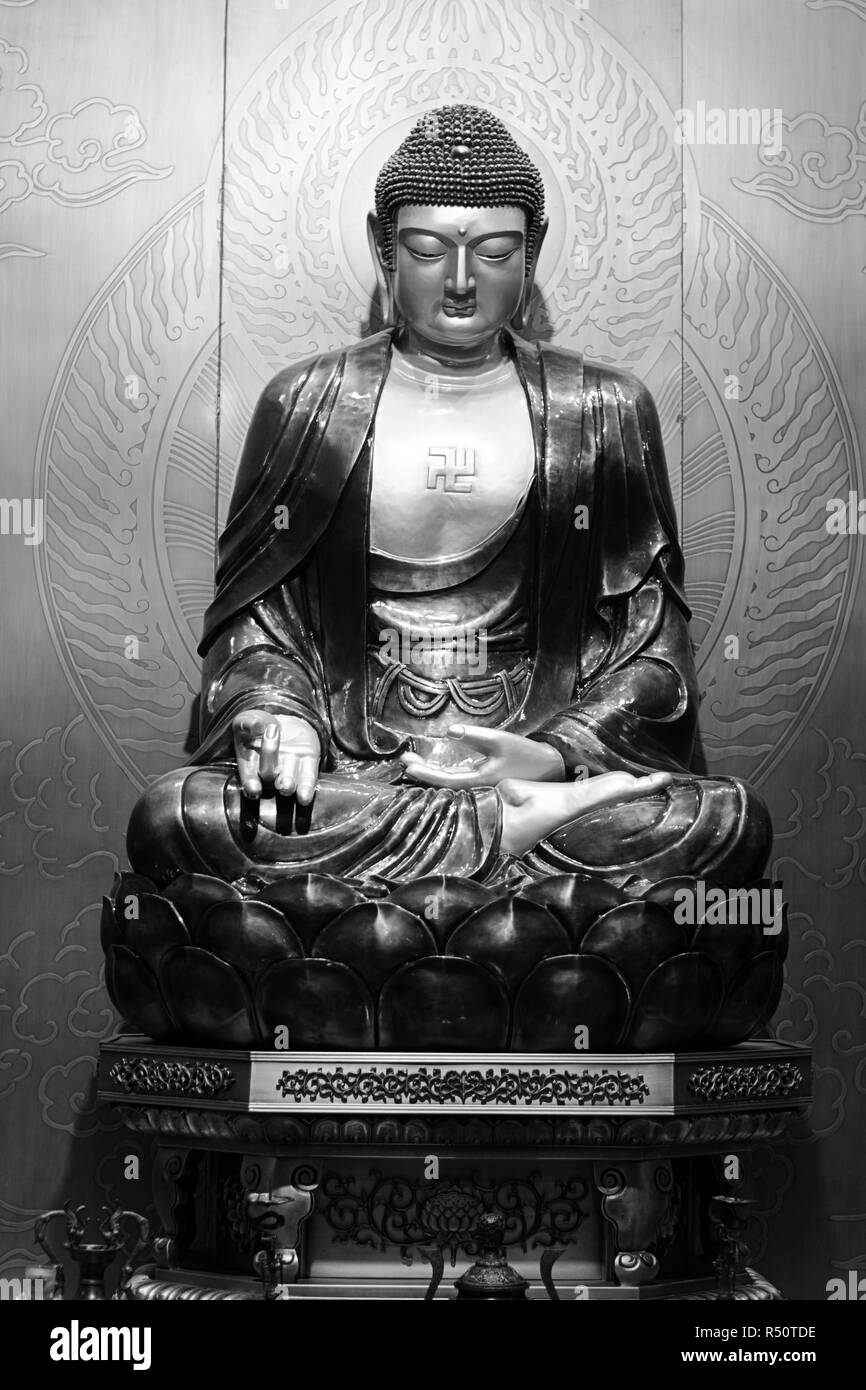 peace spirituality symbol Buddha china Stock Photohttps://www.alamy.com/image-license-details/?v=1https://www.alamy.com/peace-spirituality-symbol-buddha-china-image226827258.html
peace spirituality symbol Buddha china Stock Photohttps://www.alamy.com/image-license-details/?v=1https://www.alamy.com/peace-spirituality-symbol-buddha-china-image226827258.htmlRFR50TDE–peace spirituality symbol Buddha china
 Lanterns outside a buddhist temple, Taiwan Stock Photohttps://www.alamy.com/image-license-details/?v=1https://www.alamy.com/lanterns-outside-a-buddhist-temple-taiwan-image5934779.html
Lanterns outside a buddhist temple, Taiwan Stock Photohttps://www.alamy.com/image-license-details/?v=1https://www.alamy.com/lanterns-outside-a-buddhist-temple-taiwan-image5934779.htmlRMA22GYC–Lanterns outside a buddhist temple, Taiwan
 Yungang grottoes cave statue stone antique black white Stock Photohttps://www.alamy.com/image-license-details/?v=1https://www.alamy.com/yungang-grottoes-cave-statue-stone-antique-black-white-image226843950.html
Yungang grottoes cave statue stone antique black white Stock Photohttps://www.alamy.com/image-license-details/?v=1https://www.alamy.com/yungang-grottoes-cave-statue-stone-antique-black-white-image226843950.htmlRFR51HNJ–Yungang grottoes cave statue stone antique black white
 White Pagoda Dagoba Bai Ta Jade Island Beihai Park Beijing Peking China Chinese Asian Asiatic Asia Stock Photohttps://www.alamy.com/image-license-details/?v=1https://www.alamy.com/white-pagoda-dagoba-bai-ta-jade-island-beihai-park-beijing-peking-image2144399.html
White Pagoda Dagoba Bai Ta Jade Island Beihai Park Beijing Peking China Chinese Asian Asiatic Asia Stock Photohttps://www.alamy.com/image-license-details/?v=1https://www.alamy.com/white-pagoda-dagoba-bai-ta-jade-island-beihai-park-beijing-peking-image2144399.htmlRMA6K890–White Pagoda Dagoba Bai Ta Jade Island Beihai Park Beijing Peking China Chinese Asian Asiatic Asia
 buddha china blue hair golden black white Stock Photohttps://www.alamy.com/image-license-details/?v=1https://www.alamy.com/buddha-china-blue-hair-golden-black-white-image226855939.html
buddha china blue hair golden black white Stock Photohttps://www.alamy.com/image-license-details/?v=1https://www.alamy.com/buddha-china-blue-hair-golden-black-white-image226855939.htmlRFR5251R–buddha china blue hair golden black white
RF2JKKYJP–chinese temple icon black vector illustration.
 Buddhist temple Kek Lok Si with Pagoda in Penang, Malaysia, Georgetown Stock Photohttps://www.alamy.com/image-license-details/?v=1https://www.alamy.com/stock-photo-buddhist-temple-kek-lok-si-with-pagoda-in-penang-malaysia-georgetown-175516807.html
Buddhist temple Kek Lok Si with Pagoda in Penang, Malaysia, Georgetown Stock Photohttps://www.alamy.com/image-license-details/?v=1https://www.alamy.com/stock-photo-buddhist-temple-kek-lok-si-with-pagoda-in-penang-malaysia-georgetown-175516807.htmlRFM5FDDB–Buddhist temple Kek Lok Si with Pagoda in Penang, Malaysia, Georgetown